CITY WEEKLY

Foul Ball Ball
The University of Utah is ready to build a baseball stadium, but it wants a piece of Sunnyside Park.
BY JOSI HINDS














































The University of Utah is ready to build a baseball stadium, but it wants a piece of Sunnyside Park.
BY JOSI HINDS












































Utah’s public schools receive and spend over $11,000 per student. That is $3,000 more than the Utah Fits All Scholarship available to private school enrollees.
There is a lot of attention paid to the weighted pupil unit (WPU), which is $4,280, confusing many in the public. It makes $11,000 seem inflated. But the WPU is only one of 75 line items that the state uses to fund public education. The other line items in the state budget include money for buildings, technology, the arts, class size reduction, teacher salary sup-
plements and many other items.
And that isn’t even all of the funding that public schools receive per student. Local districts can create a variety of property taxes, implement school fees, issue bonds and receive donations or fundraise for special projects (would anyone like to buy a candy bar?)
But wait, there’s more! The federal government also provides funding for things like special education, school lunch and other programs.
So, when people say that Utah Fits All is overfunded compared to public schools, you can help them understand the true public school funding.
JON ENGLAND Libertas InstituteVote “No” on the flavored vaping ban! It is ridiculous that responsible adults can’t use flavored vaping products and would have to resort to cigarettes because parents can’t control their children and monitor them.
When are we going to stop punishing the masses because parents have little oversight over their kids? What is the purpose? Seriously, all of the other drugs and alcohol that are on the market aren’t getting touched at all.
Why don’t we ban alcohol? Cigarettes? Or candy that makes our kids unhealthy? There’s far bigger concerns here than this. I implore the Utah Legislature to vote “No” on SB61. Many businesses are going to be destroyed by this bill.
ZACHARY WISECottonwood Heights
I’m OK with banning “diversity” initiatives. If you guys, at this point, haven’t realized this is abominable, you’re part of the problem. Well done for the Republicans in my state!
RB18
Via Instagram
Each year, it seems the Utah Legislature outdoes itself trying to be even more greedy and/or hateful than the previous

years. We are living in such upside-down times these days.
JENNIFERKSLC
Via Instagram
Great article! Thank you for bringing awareness to the bills that are currently moving through Utah Legislature.
LDHREALESTATE
Via Instagram
Normalize alcohol laws and separate the church from the Legislature, and you’ll have lots of outside investors flocking here.
EXCDNGUY
Via Instagram
Nobody is dictating who can’t use a restroom. They’re saying men stay in men’s bathrooms, women stay in women’s bathrooms. It’s really not that hard. Don’t like it? Then stop being a creep and use the correct bathroom.
ARCANGELOILDEMONI
Via Instagram
If you could get transported to any time period just for fun, where would you go and why?
Wes Long
The 1890s/1900s period. So much was going on then that fascinates me and the aesthetic pleasures of that era’s architecture, etc., whisper a special kind of magic to my romantic soul.
Katharine Biele
I’m having enough trouble in this one, so I don’t want to push my luck.
Krista Maggard
I’d try to do some good and head back to the 1950s—try to prevent the switch from paper and glass to plastic! Obviously, plastic has purpose in some use cases, but we’ll be dealing with the aftermath of everyday plastic waste for centuries.
Sofia Cifuentes
In Paris in the 1920s, more precisely in the cafes where creatives, artists and bohemians met, in the heyday where sociopolitical, musical and artistic movements such as jazz, photography, fashion, surrealism, art deco and cubism were produced and transformed.
Benjamin Wood
I’d go back to the 1950s and try to stop Utah from 1. destroying its electrified passenger rail and 2. building Interstate 15 through the middle of Salt Lake City.

Idon’t make but perhaps two trips a year past our Utah State Capitol, having learned that—for me—it provides little else than heartburn wrought by decades of political malfeasance whenever I see it. So, I avoid it. That’s a real shame, as I recognize it as a beautiful structure and have fond memories of my first visit there in the late 1950s, and of subsequent visits with my classmates from Copperton Elementary on grade-school field trips.
For kids from faraway Bingham Canyon in the Oquirrh Mountains, the Utah State Capitol was a sight to behold, constructed as it is from stone and not wood or cinder blocks. We never really knew such permanence, as the homes and buildings we grew up in were obliterated by the expanding Kennecott Copper Mine. In time, everything was torn down, all of our solid buildings. Copperton Elementary? A parking lot. Bingham High School? A pile of dirt. And they are the lucky ones.
Up in the canyon, everything we knew was not only torn down, but also buried. The elementary schools in Bingham and Highland Boy, the original Bingham High, the post office, the jail, the Gemmel Club, the Civic Center, the Princess Theater, the Bingham Clinic and so on. Up and down the canyon, every store, every structure, every home that housed the peak population of around 10,000 people vanished long ago.
Therefore, the preservation of a building such as our Utah State Capitol was reassuring to us, something that people who still live and shop in the neighborhoods they grew up in may have a harder time relating to.
We kids all marveled at the Mormon Meteor display, the Bonneville Salt Flats racer developed by Ab Jenkins that
flew along the salt at nearly 175 mph. That’s about what a Tesla does these days on the way to the local grocer (assuming it has a fully charged battery). It was a sight for those of us who grew up traveling canyon roads that were narrower than the Mormon Meteor was long.
We gawked upward into the rotunda and pointed at the paintings that even back then—well painted or otherwise— we recognized as fantastical versions of what life among the early explorers, the pioneering locals and original Native Americans was really like.
I mean, it’s true that it’s hard to bullshit a kid from Bingham Canyon, Utah. Our realities were nothing like those painted inside our state Capitol. Our menfolk were smoking self-rolled cigarettes and losing hands in mine explosions while our womenfolk were hanging wet laundry out to dry in the dead of winter—not gawking at blue lake waters or forests of green. Half of our neighbors could barely understand the other half, thanks to nearly everyone being the child or grandchild of an immigrant. To be sure, however, we did get along.
Back at school, we were sometimes asked to draw or sketch a memory from those field trips. I don’t remember a single such drawing other than those that simply expressed the building’s exterior, with the dominant capitol dome sometimes accurately portrayed and other times more resembling a melting ice cream cone. But melting or sturdy, there was always a flag flaying in each of those drawings, our stars and stripes waving proudly in the wind.
Not once did a kid go back to school and pencil in the second flag waving up there, the Utah state flag. That wasn’t due to everyone forgetting that they saw it—rather, even a child’s eye could tell that the Utah state flag was the ugliest flag known to humanity. Plus, why have a flag that also doubles as a spelling test?



How it became so revered is one of the great mysteries of my life among the Utahns. As flags go, it was a joke. If you put our old flag next to that of Belize, most Utahns couldn’t tell the difference.
That’s why today, as I was driving down State Street, I nearly drove off the road when I saw the new Utah state flag waving in the wind, rightfully beneath the Stars and Stripes, but waving nonetheless on the property that houses the O.C. Tanner office complex. It, believe it or not, was the first time in these years of hubbub regarding Utah’s adoption of a new state flag that I actually saw one up close and personal. Until today, all I’d seen were artist renderings. Heck, our office is downtown, and I’d not even looked up at the City & County Building and noticed our new flag.
All I really know is that we have a new flag and that many Utahns spent the past couple of years arguing about what a redesigned flag should signify. There even remains some radical, woeful diehards like gubernatorial hopeful Phil “Presidential Pardon” Lyman who still attempt to make issue with Utah’s new flag. Simply put, I wouldn’t give a single flesh-tone Crayola of credit to anything that Lyman may offer up relating to what a state or national flag stands for or symbolizes.
If you asked 1,000 school kids to draw the new Utah state flag, 999 of them could do it. Take those same kids and ask them to draw our former historical flag, and 999 of those would just as likely draw a cat’s eye marble sitting on a plate of blueberry pudding.
The new design is red, white and a really dark blue in color. It has some yellow—I guess to impart rays of hope or something like that. It has a star and a giant beehive. It’s simple. It makes a point. I like it.CW
Send comments to john@cityweekly.net






They shall never see a poem lovely as a tree—or something along those lines. Despite Erin Mendenhall’s 1,000-tree planting initiative, it’s not just about digging them into the ground. Drought, clay soil and historical redlining have kept the west side of Salt Lake City an urban hot spot. And now, an apartment development is about to cut down 20 trees in Rose Park. Residents are not happy, even while the apartment manager says the trees are dying and might fall. Trees die all the time on the west side. In 2019, they died off at a rate of 20% compared to a 12.5% die-off on the east side. Water is part of the problem, but not all of it. The city plants trees but doesn’t necessarily follow through with education and upkeep. A century ago, minority populations were kept from the more desirable and tree-lined east side and have since suffered greater health problems because of it. The city needs to focus on the life of trees, not just the planting of them.
“Warning: May cause Leftist meltdown.” Indeed, gubernatorial candidate Phil Lyman’s social media shows just how dark and ominous the future will be even without you-know-who in the White House. At almost four minutes long, you’d think Lyman’s new ad was more about the zombie apocalypse than a MAGA future. “It seeks to erase us … now they have come for us and they have come for our children,” it proclaims. “We are great men. We are great men with a great leader,” it repeats in case you didn’t get that the future is about men, mostly white, but men led by “Trump 2024.” No mention of Joe Biden in the video, which this time leaves out the spiritual message from a previous video proclaiming “God made Trump.” There is, however, some truth in the video, which talks about a hurricane of deceit and moral decay. You can write in whoever you think that was about.
Utah is the unequivocal leader in natural landscapes, parks and even dark skies. A recent Salt Lake Tribune story pointed out that we lead the nation with 23 Dark Sky designations. That’s not nothing, considering how development is spreading throughout the state. Now, Moab may be the recipient of the state’s 24th Dark Sky designation, although it’s not a done deal. They’ve been working for five years on rules that might restrict businesses from lighting after they close. Seems logical, doesn’t it? But dark skies are fading at an alarming rate. Former Salt Lake City Mayor Rocky Anderson tried to make it happen in 2006 with a street lighting policy. The street lights still shine upward. And the Wasatch County Council approved outdoor church lighting for a new temple despite pushback from the community. If Moab succeeds, urbanites will be flocking there to see the stars. CW
We just got through the dark days of winter. High five to those who struggle with winter blues and made it through. I, personally, am over the cold and miss the sunshine.
Between 4% and 6% of people in the United States are believed to have seasonal affective disorder, or SAD, according to the American Academy of Family Physicians. And as many as 20% may experience a mild form of it—the “winter blues”—that starts when days get shorter and colder.
SAD is more commonly observed in women, young adults and individuals residing farther from the equator. Those with a family history or previous diagnosis of depression or bipolar disorder may be particularly vulnerable.
As we still have the remainder of winter ahead, February can often evoke feelings of bleakness, coldness and dreariness. Here’s some tips while looking ahead to spring. Consider engaging in a new winter activity—such as skiing, snowshoeing, ice skating or sledding—to add some excitement and enjoyment to the season. The University of Utah offers affordable options to rent outdoor recreation gear.
Practice mindfulness through meditation, journaling or breathing exercises. Continue or establish an exercise routine. Check to see what events and programs your local neighborhood is offering. Mine is offering free yoga classes twice a week and a free exercise class twice a week. We love Sunday nights at Full Circle Yoga.
Try light therapy with a light lamp. They start as low as $20. If your financial situation permits, consider traveling or working in a remote location. My friends, Alan and Sadie, have the flexibility to work remotely and frequently embark on trips to enjoy sunny destinations. Similarly, my friend Christie recently returned from Costa Rica as she is aware of how seasonal depression impacts her well-being.
If traveling is not feasible, a staycation can be a viable alternative. Even a brief respite from your routine can be beneficial in managing winter depression. Find community—who else do you know that struggles in the winter? Set up regular meetings for tea or chats. You could rotate houses or locations. I take a vitamin D supplement (with doctor’s supervision) and drink plenty of water. Studies have shown that magnesium deficiency is associated with an increased risk of depression. Taking a supplement may help alleviate symptoms of SAD.
How is your sleep routine? Are you obtaining sufficient sleep? Is the quality of your sleep satisfactory? In my family, we have enhanced the quality of our sleep by relocating pets from our bedroom (rest assured, they are content with their minky blankets). Adhering to a consistent schedule often enhances sleep, which can alleviate symptoms of seasonal depression.
It’s acceptable for humans, as with bears, to take a period of rest and rejuvenation during the winter. Our bodies require time to recharge. Achieving a healthy equilibrium is crucial. Spring will be here before we know it! CW



In Expected Image, three photographers explore how photos of the landscape shape our expectations of it.
BY SCOTT RENSHAW scottr@cityweekly.net @scottrenshawIn Utah, the landscape and the natural world form a huge part of the state’s identity. Yet while we think we know what that landscape looks like—and what we expect it to look like—that idea is one shaped by a wide range of factors. And that idea can even determine how we decide what a particular place is “worth.”
Currently on display at the Utah Museum of Contemporary Art, Expected Image finds the artistic collective Everything Is Collective—made up of UMOCA marketing & graphic design staffer Zachary Norman, Texas-based Aaron Hegert and Chicagobased Jason Lukas—exploring in part the way the Bureau of Land Management’s Visual Resource Management (VRM) system determines the scenic value of America’s public lands. For the three photographers, it’s a way to help understand how their art form is part of a process that doesn’t just capture an image, but helps shape what we expect that image to look like.
According to Norman, the trio behind Everything Is Collective first met when they were all graduate students at the University of Indiana-Bloomington, working on their MFAs in photography. “We were
all doing in-studio photography, kind of bumping into each other, looking for ways to collaboratively produce a single photograph,” Norman recalls. “And that was an interesting problem to solve. We’d upload to a server, then we’d forget who was responsible for what image.”
After graduation, Norman, Hegert and Lukas all went their separate geographical ways, but remained interested in continuing to work together. While Norman can’t recall the specifics behind how the Expected Image project originated, he says it stems from the group’s members finding it interesting how photography has been used not just as a creative form, but for many other purposes. “We’ve always been interested in how different disciplines use the medium of photography,” he says. “There’s a long history of fine art photography, but there’s also this bureaucratic or institutional use of photography.”
That includes the use of photographic images as part of the attempts by people to claim and exploit the landscape’s natural resources. Norman notes that historically, people might visit a location that they thought might have minerals worth mining, take pictures, “mark [them] up with a marker, and submit these photographs to the proper organization to get a lease on the land. They were documenting their desire with a camera. And we thought this was a fascinating use of the medium.”
As Norman, Hegert and Lukas investigated the history of those processes, they discovered the VRM system, and how it was used through that process on the land, specifically the terminology of an “expected image” as it applies to what a visitor expects to see when they visit a given location. Yet they also liked the idea of playing with that term in the context of fine arts, where the goal of the creator is generally to deliver something unexpected.

One challenge with this project, however, was that they were dealing with the products of government entities—and not surprisingly, there was already a certain overly-convoluted component to the way those entities operated, which could confuse potential viewers. “We worked on this project for so long, employed so many different solutions to the idea of sharing this process for people,” Norman says. “It’s already such a sophisticated, byzantine, complex system, that for us to try to reinterpret it would be even more complex. So a lot is just appropriation. It is kind of absurd the amount of bureaucratic language and infrastructure built around the image of beauty in the landscape.”
The exhibit then consists of a variety of materials, including documents created by the BLM and the photographers’ own images. There’s also a two-channel video piece with one image representing a Google Earth studio flyover of locations in Western states, juxtaposed with video of the artists on the ground, according to
Norman, “dealing with the landscape in a real way: dealing with the contours of the landscape, running into things. There’s the world of images and data, and the world of reality.”
The resulting cumulative effect is one that conveys both where the worlds of fine-art images and functional governmental images diverge, and where they overlap. “The thing that stuck out initially,” Norman says, “is we’re all artists and art educators, we’ve taught Photography 101 classes, and the foundations of the BLM’s system are these art terms. They have a list of this art vocabulary. This is art creating nature; there’s a feedback loop here. We’re projecting our expectations of photography back onto nature.” CW
EVERYTHING IS COLLECTIVE: EXPECTED IMAGE
Utah Museum of Contemporary Art 20 S. West Temple Through April 27 utahmoca.org

The artistic canon is always evolving, and always looking to address historical inequities in representation. Three of the most active female artists of Japanese descent in the pre-World War II era— Miki Hayakawa, Hisako Hibi and Miné Okubo—are only just becoming subjects for study in 20th-century art history, and the Utah Museum of Fine Art is proud to participate in the re-discovery of these artists, with the touring exhibition Pictures of Belonging showcasing more than 100 of their works, and making its first stop in Utah.
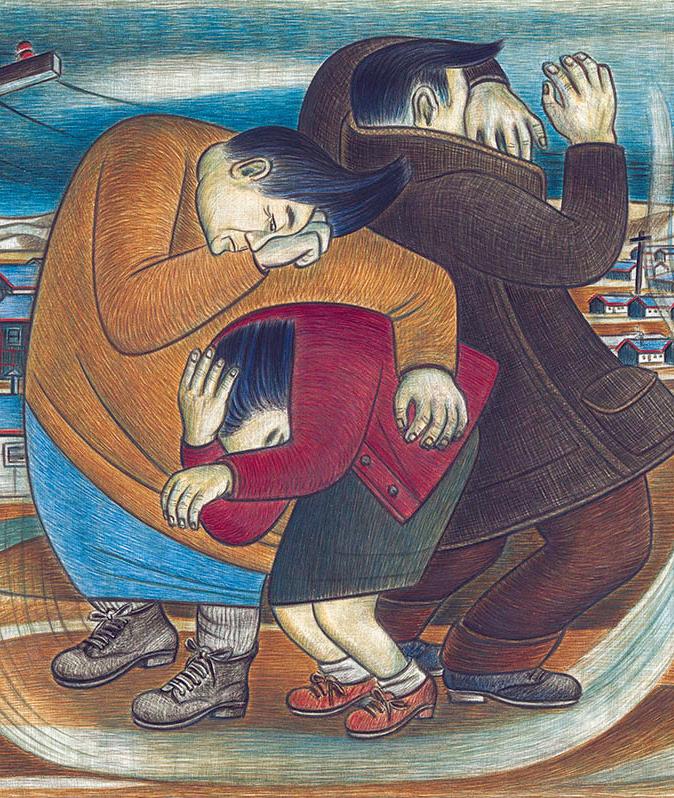
By showcasing the work by these three women, UMFA and Pictures of Belonging bring to the forefront voices that have often been diminished. The artists depict everyday life of their time, like Hisako Hibi’s 1955 oil painting “Waiting for a Bus to Work,” yet are also chronicles of very particular historical moments. Hibi and Okubo were both among the thousands of Japanese-Americans unjustly imprisoned in internment camps during World War II, and their work offers an insight into the experience of those places (Okubo’s 1943 watercolor “Wind and Dust” is pictured). Pictures of Belonging runs now through June 30 at the Utah Museum of Fine Arts (410 Campus Center Dr.), with regular hours 10 a.m. – 5 p.m. Tuesday and Thursday – Sunday, and 10 a.m. – 8 p.m. Wednesday. Events associated with the exhibition will include a curator talk with Dr. ShiPu Wang at the museum on March 13 at 6 p.m., and a Third Saturday for Families opportunity to use the paintings as inspiration for your own paintings on March 16, 1 p.m. – 4 p.m. Visit umfa.utah.edu for additional information. (Scott Renshaw)
It’s easy to exoticize the traditions of cultures from which we ourselves do not originate, losing track of their cultural significance as they are appropriated into generically “new age” spirituality. Artistic work can often ground those traditions in a cultural present, making it clear that they emerge from the lived existence of a people. The fascinating solo exhibit Healing Power of the Mystical Mestizaje at Ogden Contemporary Arts finds artist-inresidence Luis Álvaro Sahagún Nuño exploring indigenous healing practices through a wide range of creative forms.

Through painting, sculpture and installations, Sahagún Nuño reveals how healing practices are inextricably connected to cultural identity, including items like the cobija blanket. “The use of the Mexican cobija in a contemporary art gallery offers a unique opportunity for critical engagement with issues of cultural representation, power dynamics, and the complexities of identity in a multicultural world,” Sagahún Nuño says. “It challenges the tendency to exoticize and fetishize ‘otherness,’ breaking down stereotypes and encouraging a more nuanced perspective on cultural exchange.” The gallery is also scheduled to host several events in conjunction with the exhibition, including an artist talk at Weber State University’s Shaw Gallery and educational workshops designed to deepen public engagement with the exhibition’s themes.
Healing Palette of Mystical Mestizaje runs at Ogden Contemporary Arts (455 25th St., Ogden) March 1 – April 21, with an opening reception featuring the artist on March 1, 6 p.m. – 9 p.m. Regular gallery hours are Wednesday – Saturday, 10 a.m. – 6 p.m. and Sunday, 11 a.m. – 4 p.m. Visit ogdencontemporaryarts.org for additional event information. (SR)
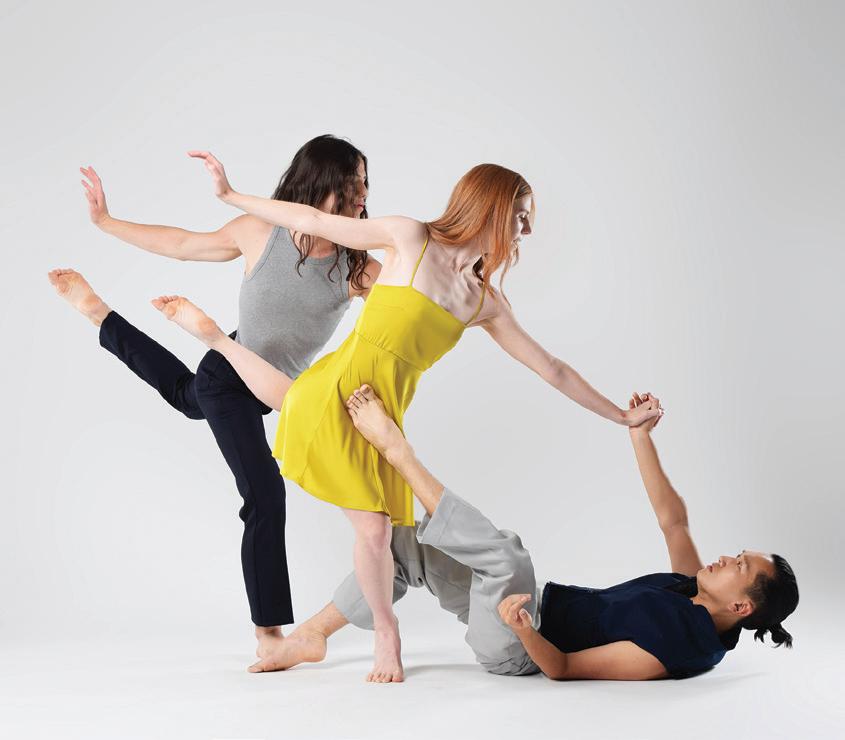
For several years, Repertory Dance Theater’s annual Regalia fundraiser has been focused around a beat-the-clock test for multiple choreographers creating new work in just a matter of hours, competing for a chance to get a commission with the company based on audience vote. For 2024, however, RDT has opted to shake things up a little: The folks tasked with creating new work in over the course of just four hours aren’t actually choreographers (at least not professionally). Instead, Regalia: So You Think You Can Choreograph brings civilians into the process of building a dance performance from the ground up. The participants are five locals, each of whom raised $2,000 for the chance at one of the available spots: Abbie St. Vaughan, an academic program coordinator at the University of Utah; Loren Lambert, a worker’s compensation and disability attorney; Lorie O’Toole, a family and parenting instructor for immigrants and refugees; Eddee Johansen, a veteran Utah restaurateur; and Dr. Richard Jaffee, a retired radiologist. Some have a little dance training, some are just fans of dance, but all will be making their first efforts at actual choreography while paired with an RDT mentor, with their creations shown to the Regalia audience. Attendees will get a chance to enjoy drinks and appetizers, tour the studios to watch the works in progress, bit on silent auction items and meet the participants.
RDT’s Regalia comes to the Rose Wagner Performing Arts Center (210 E. 300 South) on Saturday, March 2 at 7 p.m. Tickets are $75; visit arttix.org to purchase tickets and for additional event information. (SR)

“It’s been my experience,” wrote Jerre Wroble on May 13, 2012, “that a transatlantic journey can rearrange the fabric of one’s life.” Unsurprisingly, then, Wroble came home from an overseas vacation only to receive news of the impending departure of Jim Rizzi, then-publisher of City Weekly.
“Given some time working at an alt-news organization, it will leave a mark on you,” Wroble observed. “And if you’re lucky, you will leave a mark on it, as Jim Rizzi has done. And sometimes, you’ll even make a difference, producing stories that have impact, that expose abuses of power and public trust—stories that ultimately change lives.”
Rizzi’s exit capped another busy year, bringing John Saltas back to active duty as publisher. And new arrivals included Bryan Young’s “Big Shiny Robot” column and Colin Wolf’s “Secret Handshake” blog for (as Wolf described it) “all things too awesome, pointless and inappropriate for print.”
Some things aren’t so beneficial, but make it into circulation anyway—like the reports then-West Valley City Mayor Mike Winder was drumming up at the Deseret News under the pseudonym “Richard Burwash.” The scandal was a byproduct of CEO Clark Gilbert, whose drive for online presence put the paper’s reporting, accountability and credibility in the back seat.
Such journalistic gaps were unfortunate, because they missed out on plenty of stories, like the firing of state archaeologists for alleged budgetary reasons. Said archaeologists’ testimonies against a UTA train stop and mixed-use development in the footprint of a prehistoric village might have had something to do with it as well.
Elsewhere, the University of Utah joined the PAC-12, The Leonardo museum and City Creek Mall opened and political redistricting further shored up power for the state’s conservatives. EnergySolutions pushed to bring “hotter” blended wastes to the state, the Uinta Basin beardtongue flower was endangered and Utah’s elected leadership postured ad nauseum against the federal government over public lands.
And this does not even plumb the depths of Matthew LaPlante’s story on a raid at a Hyrum meatpacking plant, Eric Peterson’s guide to Mormons who diverge from conservative thought and Stephen Dark’s report

on Goshute efforts to save land and water at Deep Creek Valley. These were stories that had the potential to change lives. And readers didn’t even need a transatlantic journey to discover them, either.
“The Occupy movement that spread across the country in fall 2011 has already changed the national discussion,” wrote San Francisco Bay Guardian (which closed in 2014) reporters Steven Jones, Tim Redmond and Yael Chanoff for the Feb. 9, 2012, cover story. “It’s brought attention to the serious, systemic problems of gross inequities of wealth and power and the mass hardships that have resulted from that imbalance.”
The initial Occupy protest sought to highlight the corrupting power of money in political systems, but subsequently broadened to encompass such issues as housing foreclosures, student debt, bank reform and jobs. Occupy groups assembled in cities across the country, Salt Lake being among them. Starting with pitched tents in Pioneer Park, Occupy SLC was forcibly relocated to Gallivan Plaza after a participant was found dead in his tent from the effects of drug use and carbon monoxide poisoning.
“Under the auspices of public-safety and public-health concerns, Mayor [Ralph] Becker and Chief [Chris] Burbank chased us all out of the park and arrested 19 of us,” wrote former City Weekly journalist and Occupy SLC participant Jesse Fruhwirth on Nov. 24, 2011. “By collectively punishing the entire group ... they violated our Fourth Amendment rights by abandoning individualized suspicion.”
Jim Catano, while sympathetic to Occupy’s aims, pointed out flaws in the initial park arrangement in a Dec. 8 letter. “I chose to not camp because the park location did not make a statement against the corruption of the political process by big money in the way [New York City’s] Wall Street camp did in the shadows of the financial institutions that tanked the economy and then got ‘rewarded’ for doing it with a bailout.”
Occupy encampments around the country have long ago been shuttered, but their participants and wide-reaching goals remain a timely admonition for the political and economic tumult we witness today.
“The important thing,” concluded Jones,
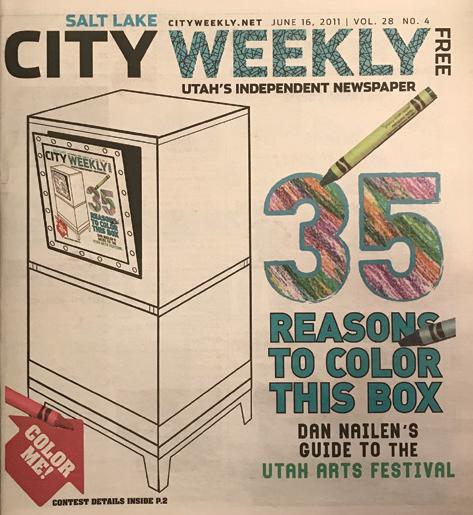


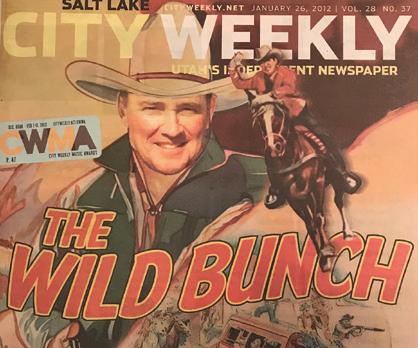
Redmond and Chanoff in their Feb. 9 story, “is to let this genie out of the bottle, to move Occupy into the next level of politics, to use a convention, rally and national event to reassert the power of the people to control our political and economic institutions—and to change or abolish them as we see fit.”
In the boxes
“City Weekly readers have long sought out our street boxes for what’s inside: a weekly newspaper,” announced Erik Daenitz in the June 23 issue of 2011. “Now, they have a new reason to look for our boxes: Public art.”
Commissioning local artists, the “Out of the Box” Art Project ran promotions to get people excited about public artwork even in the most nondescript objects. Through a special “fillin” cover for our June 16 issue, readers were even encouraged to add some color of their own to newsstands to receive tickets to the Utah Arts Festival. The artist-designed boxes were placed on display at the festival and later installed around the city for public use.
The brainchild of designer Derek Carlisle and marketing director Jackie Briggs, “Out of the Box” ran for the next five years. “We should have researched which paint stays on metal boxes so that the artist knew what medium they would be working in,” Carlisle later noted. “It is a hard surface to work on to make the art last. The boxes were often put in locations that received a ton of abuse and some artists were bummed out.”
Today, only a few of the artist-designed boxes remain in use. Glitches and vandalism aside, Briggs still takes great satisfaction from the overall effort. “I see some of them around town still and I just love how we were able to add more personality and art around the city,” she recently wrote. “Also, it’s one of those things we got to do and ask for forgiveness later [as Salt Lake City has regulations on how street boxes should look]. Turns out, the city really loved having them around town.”
“A bill working its way through the 2012 Legislature wants to take animal activists’ undercover investigations of farm conditions out behind the barn and put them down for good,” reported Eric Peterson on March 1. Sponsored by Rep. John Mathis, R-


Vernal, HB187 criminalized the recording of factory and slaughterhouse operations.
The bill was framed, Peterson observed, by “those who see animal-rights activists as extremist groups.” Indeed, the bill’s Senate sponsor, Orangeville Republican David Hinkins, was explicit, saying the bill would stop “the vegetarian people,” whom he compared to “terrorists.”
Jeff Kerr, counsel for the national People for the Ethical Treatment of Animals (PETA), told Peterson HB187 was “an attempt to criminalize the exposing of criminal behavior.” He countered the law ought to require cameras, as undercover investigations had exposed such ghastly incidents as workers kicking chickens like footballs, the pepper spraying of animals and even the sexual assault of pigs with herding canes.
“Shame on the Legislature for bowing to special interests and creating a hidden world where criminal activity and animal abuse can more safely flourish,” wrote Amy Meyer in a March 15 letter. Meyer subsequently became the first person charged under the new law when she recorded images of an apparently sick cow being pushed by a bulldozer at a Draper slaughterhouse.
“I was pretty shocked at how they responded to me,” Meyer told City Weekly in 2021. “I didn’t think they would care at all that a 25-year-old woman on a Friday afternoon had a camera on the outside of their building. That’s how threatened they are by people seeing what’s happening.”
Meyer challenged HB187 in court and received a broad base of support from not only animal activists, but also conservative groups and journalists, given the law’s effect upon First Amendment protections.
HB187 was ultimately ruled unconstitutional in 2017, but that has not stopped Utah legislators from trying other avenues to shield animal industries from scrutiny, such as Tremonton Republican Sen. Scott Sandall’s successful SB113 in 2023, which prevents counties and municipalities from enforcing any ordinance or regulation that impedes an animal enterprise. As of this writing, Rep. Walt Brooks, R-St. George, has sponsored a bill that prevents granting legal personhood (and thus recognizing any rights or privileges) to nonhuman creatures, plants or bodies of water. CW
Dune Part Two builds a saga that actually deserves additional chapters.
BY SCOTT RENSHAW scottr@cityweekly.net @scottrenshawIn case you were expecting that a movie titled Dune: Part Two would offer more narrative resolution than you could get in Dune: Part One, you would be well-served to temper those expectations. Even after a grand total of more than five hours spent in the world of Frank Herbert’s sciencefiction saga, director Denis Villeneuve and his screenwriting team still leave audiences dangling, suggesting that there’s more yet to come, cinematically speaking, in the story of Paul Atreides (Timothée Chalamet). It’s the kind of gambit that has worked for the Marvel Cinematic Universe—well, worked for a surprisingly long time, anyway—built on the assumption that you’ve actually constructed a world worth re-visiting.
In this particular case, it’s hard not to concede that the mission is accomplished. Villeneuve’s Dune-iverse feels unusually substantial for a 21st-century genre blockbuster, not just in terms of seeming to exist physically rather than simply on a hard drive, but in crafting a tale about the intersection between religion and politics that also kicks ass as spectacle.
Part Two opens with Paul and his pregnant mother Jessica (Rebecca Ferguson) living among the desert-dwelling Fremen on Arrakis after surviving the attack on his family by the Harkonnens in Part One It’s a precarious situation for them, one that could cause a rift between two Fremen factions—one, including their leader Stilgar (Javier Bardem) that believes Paul


might be a promised “messiah,” and another concerned about the possibility that any outsiders might be spies. But Paul soon proves useful as a fighter in the Fremen’s guerrilla war against the Harkonnen spice-mining operations, making him a target of Baron Harkonnen (Stellan Skarsgård) and his governor, Beast Rabban (Dave Bautista).
The amount of time Villeneuve and company get to explore this story allows for plenty of detail, and the richness of that details comprises a significant part of what has made both Dune chapters so effective. We’re allowed a deep understanding of the Fremen as a culture, including the reverence with which they treat Arrakis’s precious water, and perhaps most significantly, an understanding that—like most real-world cultures, and unlike most fantasy-world cultures—this culture is not homogenous in its beliefs. It also helps that when Paul has to undergo a rite of passage like learning how to summon and ride one of Arrakis’s massive sandworms, it makes for impressively grand-scale cinema.
That commitment to a sense of awe and wonder has often been part of Villeneuve’s


filmmaking, and once again he delivers scenes with a distinctive flair, which is particularly impressive given how much of the action takes place against a potentially monotonous landscape of sand dunes. That’s certainly true of the action sequences built around the Fremen’s rebel attacks, which provide a sense of physicality both in the hand-to-hand combat and in rendering of the Harkonnen harvesters and warships. Yet Villeneuve also takes advantage of other unique settings, like the Harkonnen homeworld with its “black sun” that renders a gladiatorial battle involving the psychopathic Feyd Rautha (Austin Butler) in an unsettling monochrome—and further allows the images of a parade in the same location to evoke the black-and-white images of other fascist pomp and circumstance.
Dune Part Two ultimately starts digging pretty deeply into the idea of political leaders taking on a mantle of being divinely chosen in order to achieve their aims, and it’s particularly deft at negotiating the terrain of cynical manipulation without making the true believers seem like suckers. Perhaps the movie is ultimately a touch to ambitious even with
all the running time at its disposal, considering it also needs to incorporate the behind-the-scenes machinations of the emperor (Christopher Walken), his daughter (Florence Pugh), the high priestess (Charlotte Rampling) and her acolyte (Léa Seydoux). That’s to say nothing of the time required to establish the romance between Paul and the Fremen warrior Chani (Zendaya), which ultimately needs to play a key role in the climax but never feels entirely convincing.
Still, Dune Part Two accomplishes far more of what it sets out to do, thematically and visually, than it falls short of doing. It’s true that we’re left with yet another cliffhanger, but five hours in, it’s wonderful that the prospect of a third film feels more like a welcome promise than a threat. CW
DUNE: PART TWO
BBB ½
Timothée Chalamet
Zendaya
Rebecca Ferguson
Rated PG-13
Available March 1 in theaters


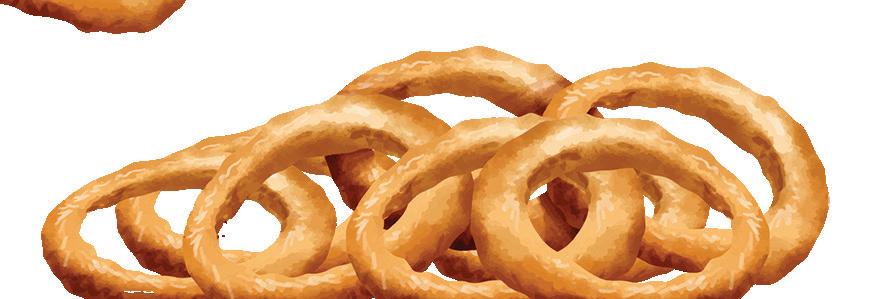












The University of Utah is ready to build a baseball stadium, but it wants a piece of Sunnyside Park.BY JOSI HINDS comments@cityweekly.net
The University of Utah Baseball team is close to realizing an almost decadelong quest to build an on-campus ballpark, and administrators say they’ve identified the perfect spot—at the current site of Utah Baseball’s practice field on Guardsman Way.
The U’s land is big enough to build a new facility, but with one caveat. To stop foul balls from getting hit out of the ballpark, U planners say the facility would have to include a 35-foot-high wall on the eastern perimeter of the outfield.
Alternatively, and to avoid the construction of this barrier, the U is pursuing a deal with Salt Lake City to lease a section of land in the adjacent Sunnyside Park.
With this additional space, administrators say, the outfield of the stadium could be extended and the construction of the wall could be avoided.
“The university wants to be a good neighbor,” said U spokesman Chris Nelson. “We want to build a facility that not only is a community asset, but we want to build a facility that actually compliments Sunnyside Park.”
If approved by the Salt Lake City Council, the U’s lease would encompass 1.175 acres that currently contain portions of a public softball field and multi-use field, both of which would be impacted by construction of the new stadium.
In exchange for use of the land, the U would commit $4.2 million for improvements to Sunnyside.
The proposal has divided residents— some argue the $4.2 million is needed to give a facelift to deteriorating park facilities, while others object to the loss of public space and what they see as a rushed plan that is light on specifics.
East Bench City Councilmember Dan Dugan said the $4.2 million figure is enough to discuss and consider theoretical upgrades to the park—like the installation of pickleball courts and an enhanced walking trail. He emphasized, though, that actual park upgrades would be chosen through a process of community engagement and with the input of local residents.
“I don’t know what those upgrades will look like after the community involve-

ment,” Dugan said. “But I’m an advocate for the improvements to the park, for the community and all its users.”
For nearly 30 years, Utah Baseball has shared Smith’s Ballpark at Main Street and 1300 South with the Salt Lake Bees. But after the Bees announced they would be leaving the city and building a new stadium in South Jordan’s Daybreak community, the U decided it was time to work on a new, oncampus ballpark.
“It’s always been the vision of the university to bring its baseball team back to campus,” Nelson said. “We want to have as many of our collegiate sports on campus as we can.”
According to an April 2023 announcement for the new stadium, the U has been evaluating potential sites for a new ballpark for nearly a decade.
Eight potential sites were narrowed down to five after the university conducted a study in 2019. The five sites included two locations on Guardsman Way and another in central campus.
Initially, the central campus location was preferred, but that site was later selected for a new student housing building.
Nelson explained that administrators are looking to group certain campus functions near each other. The central campus site is located next to Lassonde Studios, another
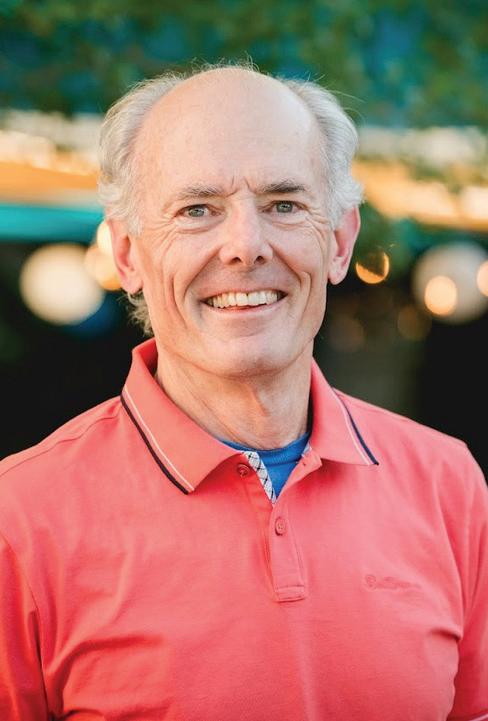
Salt Lake City Council Member Dan Dugan, above, says that a proposed University of Utah Baseball stadium on Guardsman Way (conceptual on the left) could facilitate enhancements to Sunnyside Park and offer benefits to surrounding neighborhoods.
student housing facility, while the Guardsman Way location is already familiar to the baseball program and near the U’s football and golf training facilities.
“Guardsman Way kind of becomes an athletics corridor for us,” Nelson explained. “[It] provides easy access for the baseball players to use the same facilities that our football players are using and our golf golfers are using.”
The full cost of building the new stadium is estimated to be $35 million, and most of those funds will be privately raised. The U hopes to break ground on the project by late spring and open the stadium in time for the 2025 season.
A final design for the stadium has not yet been reached. Administrators wanted public input on the stadium first, and the U will decide on a final design once they know whether the land lease has been accepted.
Part of these final determinations, Nelson said, includes campus investment in Sunnyside Park.
Dugan said he believes the agreement would benefit Sunnyside. He acknowledged the high usage of park’s existing field by members of the public, and the need for better maintenance.
Sunnyside Park has already been approved for $750,000 from the recent parks bond. That means that if the lease agreement goes through, Sunnyside Park would have nearly $5 million in new funding for maintenance and enhancement.
Dugan also said the community benefit from the new stadium could go above and beyond a cash infusion. For example, the outfield of the ballpark could be opened for public use during the offseason and act as an additional field for park users. “I’m demanding that we get [at least the] $4.2 million,” Dugan said. “That’s non-negotiable.”
An official contract has not yet been negotiated, but the city is looking at leasing the land to the U at a below-market rate of $1 a year for 99 years. A discounted rate like this one is typical for lease agreements with nonprofits and requires Council approval.
Dugan explained that the city retains the rights to land they lease. So, if the U were to theoretically break its lease agreement, the city would have the right to reclaim the land and the U would have to remove whatever they’d done on the property.
The proposal to lease public land to the U has been met with some concerns.
“What we don’t want to see is losing any land in this park,” said Mary O’Connell, chairwoman of Friends of Sunnyside Park. “We, the Friends of Sunnyside, believe this will set a precedent that any park could be given, sold or leased.”
O’Connell pointed out this proposal’s failure to adhere to the East Bench Master Plan, which was adopted by the City Council in 2017 and aimed to guide future policies

and development in the East Bench Area.
Part of this plan encouraged the expansion of Sunnyside Park—not its reduction—specifically through the acquisition of land located between the park and Steiner Aquatic Center, which is where the U’s stadium would be located.
In a written comment to the City Council, Yalecrest Community Council chairwoman Jan Hemming echoed O’Connell’s concern, stating that the lease agreement “contradicts the intent and spirit of the East Bench Master Plan.”
Nelson said the U is sensitive to public concerns regarding the loss of a softball and multi-use field, but that the monetary investment the U would give to Sunnyside Park could help mitigate those losses. He said the money could go toward improving and maintaining the fields the park would keep, for example. “I think what everyone has been excited for as we started this conversation is ‘Boy, what will the city be able to do with that additional investment in this park?’” Nelson said.
Other common concerns with the project regard light and noise pollution and traffic, concerns raised against virtually every proposed change within the city.
According to the U’s website for this project, the stadium design will include berms and a sound system focused inside the ballpark to reduce noise pollution and lighting will be designed to reduce spillover beyond the stadium.
The discussions around improvements to Sunnyside Park have touched on a larger, city-wide issue surrounding park maintenance and funding—namely, that it is severely lacking.
“Every park in Salt Lake City, they all need better upkeep to their playing fields,” O’Connell said.
August Watcher, president of the Foothill Youth Baseball Association, has used these conversations as an opportunity to bring attention to just how much upkeep playing fields in Salt Lake need, and the effect it’s had on youth baseball programs.

Guardsman Way is also served by high frequency bus lines and the university is broadly a transit-accessible destination, second only to downtown Salt Lake City in its bus and train connections.
If congestion becomes a problem, Nelson said the University would work with its police department and other agencies to direct traffic, as they do at other events. He also noted that the average attendance at Utah Baseball games is around 350 people. “In terms of traffic, based on the number of people who attend these games, I don’t think it’s a dramatic increase,” Nelson said.
Similarly, in terms of parking concerns, Nelson said the University would work to direct game attendees to park in nearby lots like the one at Rice Eccles Stadium. If parking became a problem, the U would work with the city to find ways to enforce appropriate parking.
“I would acknowledge there’s always frustration about the university,” Nelson said. “We bring, you know, almost 70,000 people to our campus every day. We have students and employees and patients.”
But the University of Utah is actively working to expand its student population to 40,000 students, which has also created cause for concern for O’Connell.
“They are surrounded by Federal Heights. They’re surrounded [to the] south by East Bench, Yalecrest,” O’Connell said. “They’re landlocked. They are just going to continue to encroach on the neighborhoods.”
Both supporters and opponents of the project alike have shared concerns regarding what they see as a lack of transparency from the university and the city.
O’Connell specifically wants the U to present complete plans for what their stadium will look like with elevations included. Without concrete plans and facts, she said, the public can’t participate properly.
“How does the public really have the ability to make an educated comment or decision when everything is potential?” O’Connell asked.
Similarly, Brandon Patterson, a regular user of Sunnyside Park, thinks the U could be more forthcoming with information on the project. For example, he said it would be nice to see a timeline of the U’s plans for the stadium or information on park improvement discussions.
Overall, though, he thinks the proposal could be beneficial for the university and the park. “I think it can be a win-win, we just need a little more communication,” Patterson said.
A public hearing on the potential land lease was held at the Salt Lake City Council meeting on Feb. 20. There, several constituents opposed to the lease agreement requested the city table a vote on the proposal until the U could provide more detailed information on their plans.
“We want the public to truly be involved before a vote is taken,” O’Connell explained.
The Foothill Youth Baseball Association has operated out of Oak Hills and the Sunnyside East complex. Watcher described how the association had to take it upon themselves to maintain the fields they use, just to make sure their teams have safe places to play ball. The association drags their fields themselves, daily, and Watcher regularly mows grass, pulls weeds and cuts back trees growing in the outfield.
“We’re all-volunteer, nonprofit organizations, and it’s up to dads like me and moms who come out here and volunteer their time to make our facilities look as nice as they can—we just have no city help,” Watcher said.
At the same time, youth baseball associations across the city are facing high rental fees that strain their ability to operate. Since 2015, Watcher said rental fees have increased by 750%. His association is spending almost $20,000 annually to rent their facilities.
Despite these rising fees, though, Watcher said he hasn’t seen any improvement in the condition of the facilities they use. The association has increased its fees because of rising costs, but Watcher said two Foothill Youth Baseball divisions will be operating at a loss this year.
“I can raise money, but I hate to raise that money, and then give it right to the city,” Watcher said. “I would much rather raise that money and offer scholarships for kids who can’t afford to play baseball.”
Watcher does support the U’s new stadium and is hoping that the city will consider allocating some of the U’s $4.2 million pledge to youth baseball programs so they can upgrade and improve their fields.
“We’re just trying to get a little bit of equity here and get the city to understand that what they’re doing to our programs is causing a huge problem for us and our ability to operate,” Watcher explained. “My point is: We’re Salt Lake City, we’re the capital city of Utah, and we should have the best fields in the state. We have the worst fields in the state.”
Watcher emphasized the fact that advocating for better playing conditions is a city-wide collaboration between youth baseball programs, which are all facing operational struggles and managing unmaintained fields.
Still, Watcher encouraged anyone who can’t afford to play baseball to email him.
“I will make sure we have scholarships available,” Watcher said. “I want people to play baseball.” CW



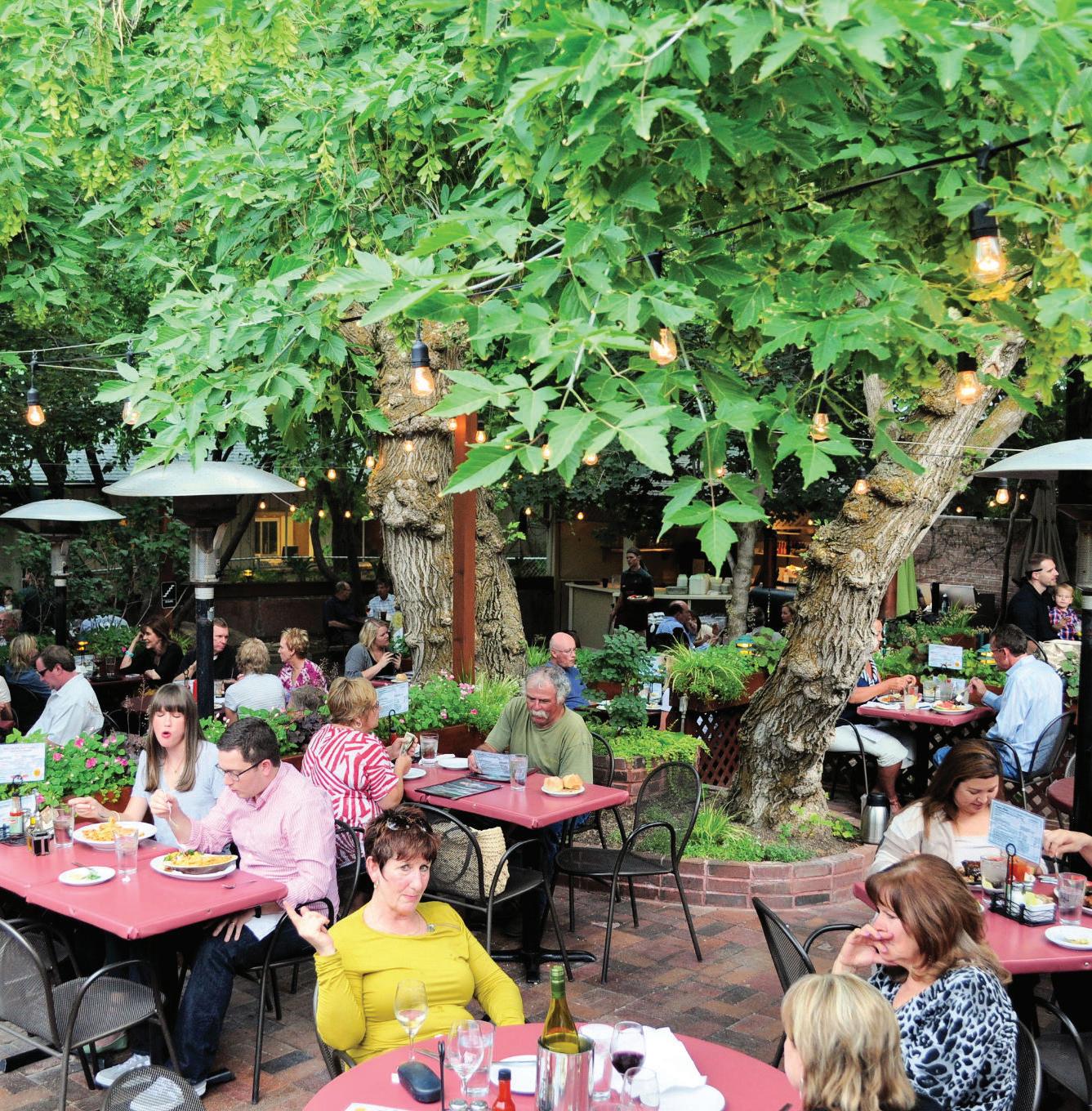



Three Nepali immigrants share their passion with the Wasatch Front.
BY ALEX SPRINGER comments@cityweekly.net @captainspringerIfirst tried momos, the Tibetan and Nepali spin on filled dumplings, at the Living Traditions festival about 10 years ago. My affection for cute round dough balls stuffed with meat and/or veggies has been pretty well documented since then, but that transformative experience has stuck with me ever since that first taste.
As momos are often on my mind, I paid a few visits to Zimbu, a fast-casual Nepali and Indian restaurant that has locations in City Creek and Sandy. Their momos are the stuff of legend, and after a recent meet-up with co-owners Raju Subedi and Kapil Thapa, I learned that he was the one serving up those fateful momos that captured my attention all those years ago.
Subedi, Thapa and their business partner Nirman Rajbhandari are the heart and soul behind Zimbu. On the outside, Zimbu might look like it’s a one of those fast-casual franchises that has recently swooped in from out of state, but this place is everything you’d want a local restaurant to be. Subedi and his colleagues met while he was attending the University of Utah; as a recent immigrant from Nepal, it wasn’t long before he made friends with Thapa and Rajbhandari who were also
from Nepal. Their shared interest in Nepali cuisine led them to work together in pursuit of a restaurant that captured all of the flavor and tradition of their native culture.
Thapa, who is the chef of the operation, has worked in restaurants for the past 20 years. “Every recipe at Zimbu bears his (Thapa’s) mark, sourced directly from his cookbook,” Subedi says. Before the trio opened the first Zimbu location in City Creek back in 2019, Thapa owned and operated the South Jordan location of local favorite Himalayan Kitchen. I also get a chance to chat with him in between orders; he can usually be found running the show at Zimbu’s Sandy location.
Both Thapa and Subedi cite a lack of fast-casual Indian food options as the motivation for opening Zimbu five years ago. “These days, food is expensive, and people may not have a lot of time to wait,” Subedi says. “So we standardized our recipes. Even when Kapil isn’t here, anyone here can make his recipes.”
This streamlined process helped their City Creek location become one of the more popular eateries in the area, though their menu did undergo a few changes after weathering the early stages of the COVID-19 pandemic. “We had to be lean,” Subedi says as he reflects on that struggle. “We selected the most popular items, and it taught us a big lesson in a hard way. It was difficult, but we stuck together.”
Their current model allows diners to select a rice, noodle or veggie base with a choice of protein—it’s one of the few Indian curry spots that serves pork—and then a choice of tikka sauce, coconut sauce and vindaloo sauce. While it was a difficult transition, paring the menu down to a choice of three sauces has actually improved Zimbu’s fast casual vibe; each sauce has its own flavor profile, so diners can easily shake things up. My current favorite is the timmur pork bowl with
the vindaloo sauce ($11.49), as the timmur pepper marinade and smoky vindaloo sauce nicely complement one another. That timmur pepper came up a lot in our conversation, as it’s a fairly common ingredient in Tebetan and Nepali food. It’s a cousin to the Sichuan peppercorn, so it imparts a bit of a citrusy tingle to the tongue, which makes it a fun ingredient for Thapa to play around with.
As tasty as the timmur pork was, my favorite use of this peppercorn was found in the creamy sauce ladled all over Zimbu’s chicken momos ($8.99). I’ve grown to love an acidic, vinegary bite to my food, and the sauce that Thapa has prepared hits all the right notes. He suggests eating these little beauties with a spoon so you can catch a generous pool of sauce with each momo, and I have to agree with him on this. According to Thapa and Subedi, this dish is the one that really captures Nepalese flavors, and it’s the one they crave even on their sojourns back to Nepal.
On the spicier side of Zimbu’s menu, diners can check out the Chilli Momo ($9.99) that sees the same homemade momo recipe dressed up in an Indo-Chinese chili sauce and topped with chopped onion and cilantro. Fans of spicy food won’t get too rocked by this interpretation, which means you get less pain and more flavor. Newbies to spicy food may want to tread a bit more carefully with this dish, however.
Regardless of what you order up at Zimbu, it’s safe to say you’re getting something directly from Thapa’s heart and soul. The passion for good food in a simple package that brought Zimbu’s owners together is still on full blast for those craving something a little different in the fast-casual world. CW
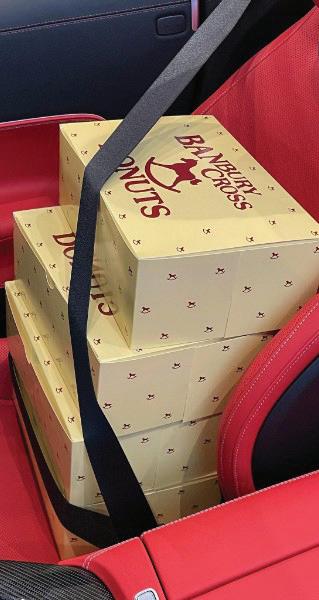




2 Row Brewing 6856 S. 300 West, Midvale 2RowBrewing.com
Avenues Proper
376 8th Ave, SLC avenuesproper.com
On Tap: Midnight Especial- Dark Mexican Lager
Bewilder Brewing
445 S. 400 West, SLC BewilderBrewing.com
On Tap: Low Hanging PhruitNew Zealand Pilsner
Bohemian Brewery 94 E. Fort Union Blvd, Midvale BohemianBrewery.com
On Tap: Boho Extra Dry Lager
Bonneville Brewery 1641 N. Main, Tooele BonnevilleBrewery.com
On Tap: Peaches and Cream Ale
Chappell Brewing
2285 S Main Street Salt Lake City, UT 84115 chappell.beer
Kiitos Brewing 608 W. 700 South, SLC KiitosBrewing.com
Level Crossing Brewing Co. 2496 S. West Temple, South Salt Lake
LevelCrossingBrewing.com
On Tap: Sinday - Pale Ale
Level Crossing Brewing Co., POST 550 So. 300 West #100, SLC
LevelCrossingBrewing.com
On Tap: Down the Road - West Coast IPA
Moab Brewing 686 S. Main, Moab TheMoabBrewery.com
On Tap: Bulliet Bourbon barrelaged Brown
Mountain West Cider 425 N. 400 West, SLC MountainWestCider.com
On Tap: Orange & Cardamom Resolutions Cider 6.9% Abv
A list of what local craft breweries and cider houses have on tap this week
Red Rock Fashion Place 6227 So. State
Redrockbrewing.com
On Tap: Munich Dunkel
Red Rock Kimball Junction 1640 Redstone Center Redrockbrewing.com
On Tap: Bamberg Rauch Bier
RoHa Brewing Project
30 Kensington Ave, SLC
RoHaBrewing.com
On Tap: Red snake Hoppy Red Ale
Roosters Brewing
Multiple Locations
RoostersBrewingCo.com
On Tap: Cyclops Irish Stout
SaltFire Brewing
2199 S. West Temple, S. Salt Lake
SaltFireBrewing.com
On Tap: Dirty Chai Stout
Salt Flats Brewing
2020 Industrial Circle, SLC SaltFlatsBeer.com
Squatters and Wasatch Brewery
1763 So 300 West SLC UT 84115 Utahbeers.com
On Tap: Wasatch Apricot Hefeweizen – Fruited Wheat Beer
Strap Tank Brewery, Lehi 3661 Outlet Pkwy, Lehi, UT StrapTankBrewery.com
On Tap: Celestial Lineage, Kölsch. 4.6%
Strap Tank Brewery, Springville 596 S 1750 W, Springville, UT StrapTankBrewery.com
On Tap: Bananza Hefeweizen
TF Brewing
936 S. 300 West, SLC TFBrewing.com
On Tap: Kiss From a Gose
BEER + PIZZA = <3
SUN-THU: 11am - 10pm • FRI-SAT: 11am - 11pm


550

On Tap: Collaboration with Cupla Coffee. | Tweek - Coffee Pale Ale
Craft by Proper 1053 E. 2100 So., SLC properbrewingco.com
On Tap: Gungan Sith Lord - Dark Lager
Desert Edge Brewery 273 Trolley Square, SLC DesertEdgeBrewery.com
On Tap: La Playa-Mexican Style lager
Epic Brewing Co. 825 S. State, SLC EpicBrewing.com
On Tap: Barrel-Aged Imperial Vanilla Porter
Fisher Brewing Co. 320 W. 800 South, SLC FisherBeer.com
On Tap: A rotation of up to 17 Fresh Beers!
Grid City Beer Works 333 W. 2100 South, SLC GridCityBeerWorks.com
On Tap: Cask Nitro CO2
Helper Beer
159 N Main Street, Helper, UT helperbeer.com
Hopkins Brewing Co.
1048 E. 2100 South, SLC HopkinsBrewingCompany.com
On Tap: Stonewall Sour Saison
Offset Bier Co 1755 Bonanza Dr Unit C, Park City offsetbier.com/ On Tap: DOPO IPA
Ogden Beer Company 358 Park Blvd, Ogden OgdenRiverBrewing.com
On Tap: Injector Hazy IPA
Park City Brewery
1764 Uinta Way C1 ParkCityBrewing.com
On Tap: Jalapeno Ale
Policy Kings Brewery
223 N. 100 West, Cedar City PolicyKingsBrewery.com
Prodigy Brewing
25 W Center St. Logan Prodigy-brewing.com
On Tap: Cached Out Hefeweisen -- Now available to go!
Proper Brewing/Proper Burger 857 So. Main & 865 So. Main properbrewingco.com
Proper Brewing: SLC Pils - Pilsner
Proper Burger: Salted Caramel Porter - Porter Brewed with Caramel and Salt
Proper Brewing Moab 1393 US-191, Moab properbrewingco.com
On Tap: YRJB - Juicy IPA
Red Rock Brewing
254 So. 200 West RedRockBrewing.com
On Tap: Gypsy Scratch
On Tap: Luau Rider - Coconut Chocolate Milk Stout
Scion Cider Bar
916 Jefferson St W, SLC
Scionciderbar.com
On Tap: Scion Dead End Sweet - 6.5% ABV
Second Summit Cider 4010 So. Main, Millcreek secondsummitcider.com
On Tap: Imperial, Dry cider with English apples
Shades Brewing
154 W. Utopia Ave, S. Salt Lake ShadesBrewing.beer
On Tap: Foggy Goggle Winter Lager
Live Music: Thursdays
Shades On State 366 S. State Street SLC Shadesonstate.com
On Tap: Hellion Blonde Ale
Silver Reef
4391 S. Enterprise Drive, St. George StGeorgeBev.com
Squatters Pub Brewery / Salt Lake Brewing Co. 147 W. Broadway, SLC saltlakebrewingco.com/ squatters
On Tap: Salt Lake Brewing Co.’s Valley Girl West Coast IPA
Talisman Brewing Co. 1258 Gibson Ave, Ogden TalismanBrewingCo.com
On Tap: The Griffen- Citrus Wheat Ale in collaboration with the 419th at Hill AFB
Top of Main Brewing
250 Main, Park City, Utah topofmainbrewpub.com
On Tap: Top of Main’s Schirf Beer Helles Pale Lager
Uinta Brewing
1722 S. Fremont Drive, SLC UintaBrewing.com
On Tap: Was Angeles Craft Beer
UTOG 2331 Grant Ave, Ogden UTOGBrewing.com
On Tap: Golden Grant 5% ABV.
Vernal Brewing 55 S. 500 East, Vernal VernalBrewing.com
Wasatch Brew Pub 2110 S. Highland Drive, SLC saltlakebrewingco.com/ wasatch
On Tap: Top of Main’s Utah Beer
Zion Brewery
95 Zion Park Blvd, Springdale ZionBrewery.com
Zolupez
205 W. 29th Street #2, Ogden Zolupez.com
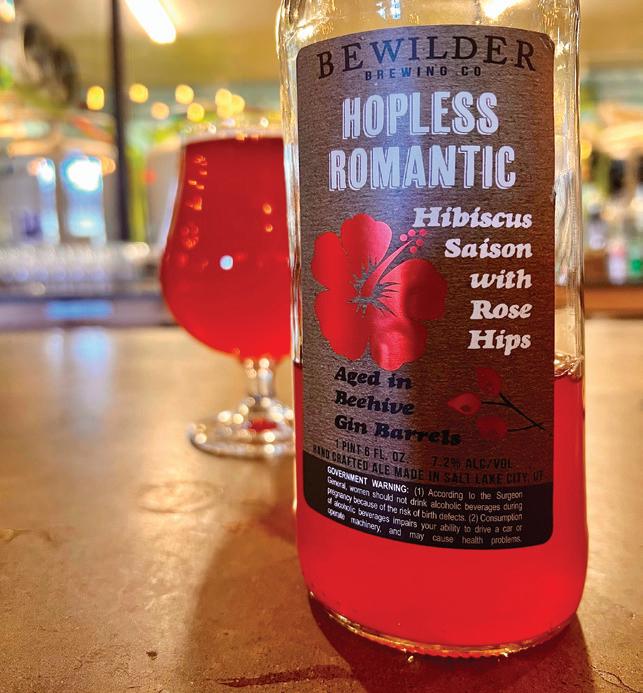
Like leap year, beers like these don’t come around very often.
BY MIKE RIEDEL comments@cityweekly.net@utahbeer
This week, we have not one but two locally-made beers that showcase more traditional botanicals, instead of hops, to enhance and bitter the individual ales. Because there are no hops used in these ales, they can be presented in clear bottles. You might be asking, “Why are clear bottles so unusual?” It’s because UV light causes hops to “skunk,” resulting in that stale, skunk-like odor that can take hold from just a few minutes of light exposure; that’s why most beers are packaged in dark bottles or cans. So, with no hops to worry about, the pink hues from the flowers in these two brews can literally shine.
Bewilder - Hopless Romantic: This Belgian-style Saison features hibiscus and rose hips, then it was aged in Beehive gin barrels. A pale pink, Rosé hue looks makes it look like a blush or a white zinfandel wine rather than a beer, except that a wine won’t form a head on it. Hopless Romantic pours a pure white head that’s pretty loose overall, but drops-out quickly and leaves a little lacing in moderate spotting. Pale malts with an obvious rose note and a little sweetness from light hibiscus make up the aroma.
Airy, gentle sweetness balances with evenly-leveled tartness for the taste as some berry skins pull through. It’s a touch lemony as well. The pale malt holds it up while the obvious floral notes rest over everything without dominating. Actually, it’s very well-constructed, as the task of keeping a beer as light as this one without openly displaying flaws is a difficult one, not to mention that making a beer this light actually have substance is pretty impressive.
Verdict: The 7.2 percent alcohol mouthfeel is as light as I’d expect, but provides some depth. The body leans toward medium, though it still rests in

light-bodied territory. Crispness doesn’t disappoint on either the light or heavy end—pretty effervescent, but not overly so—and it’s fairly smooth as well. The gin barrel influence is quite subtle, until the beer warms, at which point the ginoaky tannins begin to take hold toward the finish.
TF - Foeder Circus Series (Rose Petals, Hibiscus and Chamomile): This ale also features hibiscus and rose hips with the addition of chamomile tea. The base beer features soured ale from TF’s Foeders (large oak fermentation vessels).
It pours a rose-hued champagne body with lively carbonation. Head retention is below what you’d expect from a beer, but again, there are no hops. An unusual but inviting aroma of caramelized malts with the impact of softly tangy fruit, a subtle tweak of earthy chamomile and prickle of bitter raw hibiscus, giving the aroma liveliness against the richerthan-expected malt body, preventing an overall cloying aroma.
A fine-tuning of the aroma generates a rich but clean malt body blended with the tart and fruity base sour ale. Earthy chamomile quickly transitions to a tart, dry finish, with a trailing hibiscus bitterness to match. Unique and punctuated flavors transition better than expected, with both the chamomile and hibiscus adding subtle complements to the flavor, instead of dominating with overbearing spice and botanical bitterness. The texture is slick, slightly chewy, smooth and very dry. Carbonation is moderate, generating a light frothiness and a moderately crisp finish. Body is medium for the style; the 7.5 percent alcohol presence is light, and there are no “off” flavors.
Verdict: Another experimental sour by TF with overall pleasing results. The chamomile plays a nice complementary role as sidekick to the rich, clean malt body, and the hibiscus accents the tart, bitter and immensely dry finish. Altogether, they form a punctuated sour ale that avoids generating cloying or overbearing flavors.
Both of these beers were designed for Valentine’s Day, but have a much broader appeal and should be enjoyed now or laid down in your cellars for a later date. As always, cheers! CW








We recently got word that Roux (515 E. 300 South)—that cozy little space that we’ve been eyeing for the past few months—has officially entered its soft opening phase. A pic of their menu is up on their Instagram page (@roux.restaurant), and it’s already got me salivating. Smoked trout dip with salt and vinegar chips? Yes, please. Lamb shank birria? I’ll have seconds. Enchilada gnocchi? I want to go to there. This little block of Broadway is home to some of downtown’s heaviest dining hitters, but I feel like Roux has the confidence and menu swagger to make a name for itself while it gets up and running during the soft opening.
The team at Canyons Village in Park City (4000 Canyons Resort Drive) recently announced its annual contest dedicated to alcoholic and nonalcoholic libations. From now until March 30, participating restaurants in Canyons Village will feature a cocktail/mocktail as part of the contest. It’s then up to diners to vote for their favorite as the contest progresses. This year, participating mixologists will need to include a minimum of two ingredients from local suppliers in their featured drink. It’s then up to Canyons Village diners to sip and vote, leading up to a $500 cash prize for the winning mixologist. If you’ve got a favored watering hole in Canyons Village, now is the time to show them your support.
Our friends at Bricks Corner (1465 S. 700 East) recently unveiled some exciting new menu specials that seek to push the boundaries of what dairy can be. First up, we’ve got a burrata pepperoni caprese pizza that goes heavy on a super creamy burrata. It’s joined with some tasty lil’ cupping pepperoni, sliced roma tomatoes and sweet baby basil. Essentially, you’ve got the freshness of a caprese salad with a traditional pepperoni pizza. For dessert, they’re whipping up Spanish Basque cheesecake, made with super-rich duck eggs. It’s hard to say which of these items will win my heart, so I’ll likely need to try both of them. At the same time.
Quote of the Week: “Just because you don’t live near a bakery doesn’t mean you have to go without cheesecake.” –Hedy Lamarr


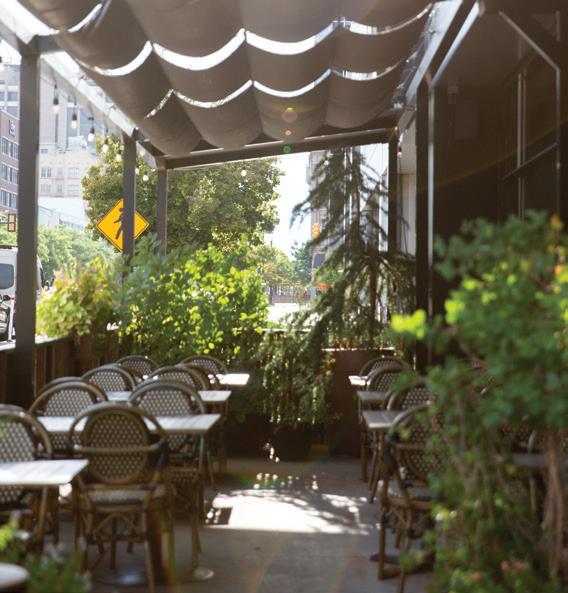













@emileelovesvinyl
If you’ve ever found yourself listening to the same 10 songs over and over, just know that you’re not alone. We all get into ruts from time to time, and it can be hard to venture out and try new artists to listen to. Luckily, SLC is brimming with incredible talent, so there’s plenty of new music to discover. Here are some songs to add to your library to freshen up your listening routine.
Hopeless & Depraved, Everything Hurts: Off to a somewhat melancholy start with this one, but there are times when you’re feeling down and you need the comfort of sad tunes to make you feel like you’re not alone. “This here be an album about drug addiction, suicidal ideation, and broken heart despair. It’s as angry and heavy as I often feel, and has proven to be far more cathartic than drugs have ever been,” says David Smalley, the man behind the moniker Hopeless & Depraved. Smalley incorporates elements from rock, punk, noise and shoegaze to create his signature sound. At times the sounds are a bit jumbled and tend to clash, but if that’s how your mind is feeling, it’s a perfect fit. You can find all of Smalley’s projects on BandCamp. https://faroutandbackagain.bandcamp.com/album/everything-hurts
Southernmost Gravy, “4 More Hours”: Greater Salt Lake City-area rockers Southernmost Gravy got their start as a band in January 2020, and we all know what happened then. Since that time however, this
EDM/rock group has broken through in the scene, gaining thousands of fans and putting out great music. “None of us really listen to EDM music ourselves, it’s not really our genre of choice,” synth/keys/producer Ben Adams told Volume Utah. “We mostly listen to ’80s and ’90s rock music, but it’s the genre we like playing. Another is that we have an alien in our band. We dress up one of our friends who used to be in the band, and he’ll come out on stage from time to time.” Their most recent single, “4 More Hours,” features a slick rap beat from hip-hop artist Axaero, and is catchy as hell. It’s a great song for your happiest playlists, and great to throw on when you have friends over. https://open.spotify.com/artist/3TcHw3wclDuMiT5alF15fG/ discography/all
Addison Grace, Driving Lessons: Addison Grace has been captivating listeners with his tender and beautiful sounds since 2020. He released several singles and EPs leading up to his debut album release in Sept 2023, Driving Lessons, an album with an overarching narrative that takes listeners on a journey through themes of innocence, trauma, anger, sadness, acceptance and, ultimately, healing. Growing up as a non-binary trans person anywhere isn’t easy, but it’s easy to imagine that it was particularly difficult in Utah, and those feelings shine through on Grace’s debut album. Despite the difficult themes of trauma and sadness, there is still a lot of hope and amazing pop elements to enjoy. https://open.spotify.com/ artist/39EIRTZx1JjfeDLVdbj2ap/discography/all
The Bombshell Flowers, The Death of Me: In 2020, many of us took a step back to reconsider things about our lives and make some changes. The same is true for Provo alt-rock group The Bombshell Flowers. They took time to redefine their sound and build up a new fan base. In 2023, they released their first full album as the rebranded Flowers entitled The Death of Me. It’s a perfect album for anyone who is a fan of indie/alt rock and is


looking for something upbeat, but not too heavy. The songs have a dreamy quality to them, feeling like music that a boy would play for a girl he has a massive crush on. This is the perfect album for a mellow night, or to keep you company on a long drive home. https://open.spotify.com/ album/3lZysrEmtEZ9WdsZCmCFjj
Utopian Nightmare, “Ghost of My Past”: I’m a sucker for goth themes in music. Growing up listening to groups like Evanescence and Within Temptation, I will also have goth sounds holding a special place in my heart. Ogden group Utopian Nightmare have these vibes in spades, especially with their debut single “Ghost of My Past.” The music itself is heavy and driving, while singer Valerie Rose Sterrett swoops in with melodic vocals and dark-themed lyrics. If you’re looking for more to feed your inner goth, look no further. https://open.spotify.com/
artist/4vtnTHcOVsudYzJVTxFUWG
Lane and the Chain, “Love’s Not Enough”: Following their 2022 self-titled debut, alt band Lane and the Chain followed up with “Love’s Not Enough” last April— and this single is Lane and the Chain at their best. That’s not to say that the rest of the music in their catalog is less significant, but this song in particular stands out (to me, anyway). It’s strong yet tender, and vocalist Courtney Lane Spaulding’s performance is especially beautiful on this one. The song is atmospheric and will have you coming back again and again for another listen. https://open.spotify.com/ album/1cj5QNH1muhwLwqiur39wH
There you have it—another list of songs that will spruce up your music library if you’re feeling like you’re in a slump. Stay tuned for more recs and support local musicians by sharing their music with a friend. CW


THURSDAYS

FRIDAY, MAR 1
DJ PARK BOI

SATURDAY, MAR 2
SAUCI

SHARK SUNDAYS POOL TOURNEY HOSTED BY TANNER

MONDAYS
REGGAE MONDAY WITH DJ NAPO

TUESDAYS

WEDNESDAYS KARAOKE

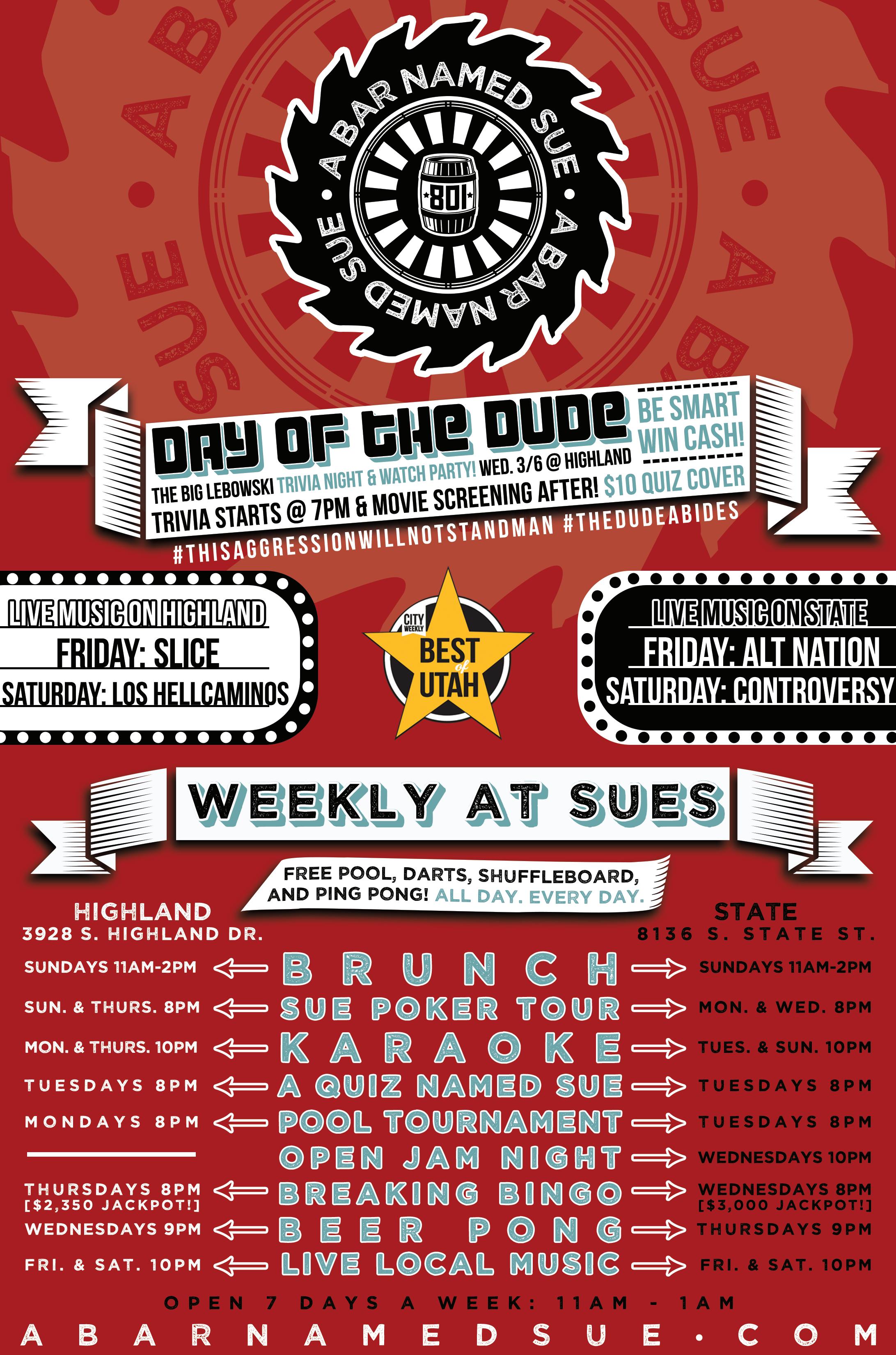


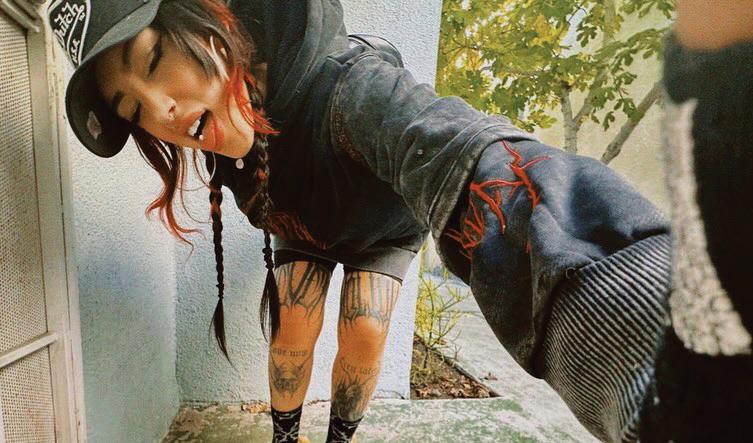

For the misfits and misunderstood, DJ and producer HVDES (pronounced “Hades”) and DJ/ producer duo Hi I’m Ghost are the perfect headliners to witness. HVDES, aka Savannah Mae, brings a sinister sound and intensity guaranteed to create a mosh pit. Mae’s roots in classical piano, alternative and punk have translated well into the EDM world; her musical versatility is shown best through her 2018 release Revelations and Fallout in 2022. The mood and lyrics of these songs focus on the darker and weightier facets of dance music, exploring themes of suffering and destruction to facilitate creation. Who better to accompany the ruler of the underworld than the bone-chilling sounds from Hi I’m Ghost? The eerie duo features Nathan Davis, a lifelong musician hailing from Los Angeles, and Tiago Nunez, a skilled audio engineer who honed his craft at the Conservatory of Recording Arts. Having toured with some of the biggest names in dubstep such as Excision, Virtual Riot and Barely Alive, they infuse their music with heavy, dark beats best exemplified on Death Rail and Spooky Riddim. Raise your metaphorical pitchforks and take comfort in the spooky bass music of HVDES and Hi I’m Ghost joining forces at Soundwell on Friday, March 1. Doors open at 9 p.m. General Admission costs $25. Go to tixr.com (Arica Roberts)










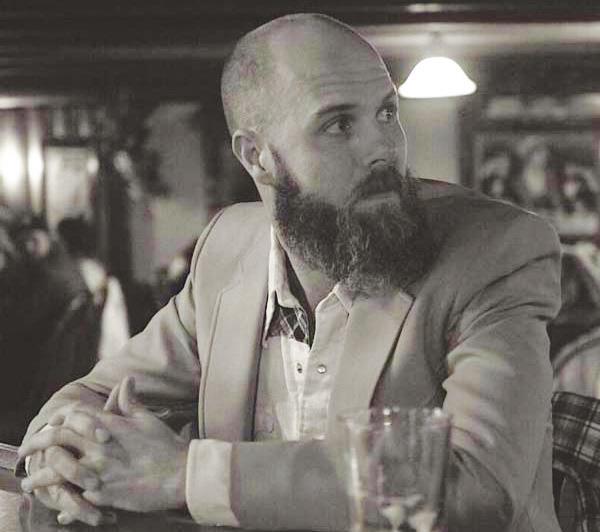



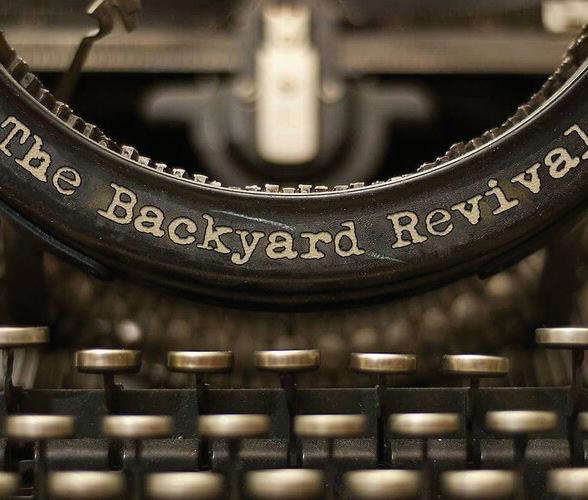










Sometimes you need a night of letting loose, headbanging and some excellent emo/punk vibes. Luckily, you’ll have just the opportunity to do so at this stacked local lineup. For fans of emo in the early aughts, you’ll immediately be transported to the good old days of hair flips, studded belts and skinny jeans with Papercut Memory’s music. It’s fast-paced, full of crunchy, driving guitar and lamenting lyrics. They’ve labeled themselves as “aggressively mediocre emo”—which is funny, but the band is definitely far from mediocre, especially if you’re a fan of the genre. Also on the bill is grunge pop group Bat Brain, a band that came together because of a birthday party, according to their The Artists and the Studio page. Members of the band got to talking, and eventually decided to get together and jam. They are now playing live shows and collecting donations to fund their debut album. If you catch the show and like what you hear, head to Bat Brain’s Instagram (@batbrainband) and consider donating to the creation of their first album. Also on for this show is American Humor, a beloved SLC alt-punk group who describe themselves as “irreverent, angry, full of existential doubt and chaotic rage.” If that’s something that interests you, you won’t want to miss this show. Catch this trio of locals at Boardwalk Sound Saturday, March 2 at 7 p.m. Tickets for the all-ages show are $10 at theboardwalksound.com. (Emilee Atkinson)







Chegoya, Antela, Snowtown @ Kilby Court 3/3
Jazz group Chegoya started 2024 right with brand new tunes for us to enjoy. Not only that, but I GUESS is the band’s debut EP. Admittedly, I’ve not spent a lot of time listening to jazz, but even if that applies to you as well, Chegoya is an excellent introduction. It’s hard not to get addicted to the fast bass and drums accompanied by smooth keys and sax. It’s a great EP if you’re looking for something where you can throw on your best headphones while sitting back with a drink, or play in the background while working on a hobby. It’s the kind of music that will have you finding new things each time you listen—and there’s a lot to hear, as the songs range from seven to nine minutes in length. Also on the bill is Antela, another group who bring a cool, funky, jazzy sound to the mix. Their latest release, “I Know,” starts out slow and mysterious before building up to an exciting romp that you won’t want to end (especially when the sax solo starts). Last but certainly not least is Snowtown, whose music is a bit different from the previous bands, but still packs a great punch. Snowtown is known for their strong ballads and upbeat electronic tunes; their first release since 2022, “You’re Not Dead Yet,” will tug at your heartstrings with its emotional lyrics and strong vocals. If you’re wanting a night with a great music variety, look no further. Catch these great local acts on Saturday, March 3 at 7 p.m. Tickets for the all-ages show are $10 and can be found at 24tix.com. (EA)

There was a point in rock’s evolution where pop and pretension existed side by side. It was an idea that originated in the late ’60s and early ’70s, when album-oriented radio (otherwise known as AOR) usurped Top 40, and suddenly catchy melodies and irresistible hooks were displaced by long, tedious instrumental passages and complex chord changes that found enjoyment and appreciation dependent on chemical enhancement. Happily, Real Estate reckon to reestablish pop’s predominant role as a means of pure, unapologetic entertainment, free of the self-conscious silliness that seems to plague so much of what passes as popular music these days. And no, they don’t rely on an army of dancers or critical commentary to get their music across. As the band’s new album Daniel proves, they find it simply enough to be tuneful, tasteful, infectious and engaging. The only actual intrigue that’s involved relates to the album title itself. What’s with naming a record after an individual, albeit someone who remains otherwise anonymous? Perhaps it’s a nod to the fact that the Replacements named one of their seminal efforts Tim. Or, as their press material points out, maybe it’s simply a sign that the band has been around long enough to take its music seriously without having to take itself all that seriously as well. Real Estate brings their Infinite Jangle Tour with special guest Florry to The Urban Lounge on Tuesday, March 5 at 7 p.m. Tickets for this 21 + show are $22 advance (+ $7.95 service fee), $25 (+ $9.08 service fee) day of show at 24tix.com (Lee Zimmerman)
The word pretentious need not be entirely pejorative—it just means that a thing pretends to be more or other than it is, that it has “pretenses,” which is sometimes another way of saying “aspirations.” Sleepytime Gorilla Museum has that level 10 turn-of-the-century hope. SGM consists of revolving vocalists and multi-instrumentalists Nils Frykdahl, Carla Kihlstedt, Michael “lago” Mellender, Matthias Bossi and Dan Rathbun, all of whom have reappeared after 13 years with their victorious new LP, of the Last Human Being. “A kind of buzzing warmth stirs in my belly. Partly, it’s the re-kindling of old friendships, but it’s also the connectivity of reigniting a community, an ethos, and a commitment to creative and independent expression, and to vibrant collectivism,” Kihlstedt said about the band’s return. “I believe in every messy molecule of SGM, from its many heads to its stinky toes, from its music to its wandering soul. How lucky are we to return to the hive after all these years?!” The grandiose beauty of Sleepytime Gorilla Museum is that of youths in an apocalyptic tomorrow; nursery rhymes are fused with cacophony, the instruments used are improvised together, the structure is both experimental and full of fun, the ambience massive but merry. Look, this is guaranteed to be one of the most interesting nights of music locally in 2024. Be there. Red Bennies and Purr Bats open. Catch these acts at Metro Music Hall on Tuesday, March 5, doors at 7 p.m. Tickets for the 21+ show are $25 at 24tix.com. (Mark Dago)

ARIES (March 21-April 19)
In my astrological estimation, the coming weeks will be an ideal time for you to declare amnesty, negotiate truces and shed long-simmering resentments. Other recommended activities: Find ways to joke about embarrassing memories, break a bad habit just because it’s fun to do so and throw away outdated stuff you no longer need. Just do the best you can as you carry out these challenging assignments; you don’t have to be perfect. For inspiration, read these wise words from poet David Whyte: “When you forgive others, they may not notice, but you will heal. Forgiveness is not something we do for others; it is a gift to ourselves.”
TAURUS (April 20-May 20)
Many of you Tauruses have a robust capacity for doing diligent, effective work. Many of you also have a robust capacity for pursuing sensual delights and cultivating healing beauty. When your mental health is functioning at peak levels, these two drives to enjoy life are complementary; they don’t get in each other’s way. If you ever fall out of your healthy rhythm, these two drives may conflict. My wish for you in the coming months is that they will be in synergistic harmony, humming along with grace. That’s also my prediction: I foresee you will do just that.
GEMINI (May 21-June 20)
Many people choose wealthy entertainers and celebrity athletes for their heroes. It doesn’t bother me if they do. Why should it? But the superstars who provoke my adoration are more likely to be artists and activists. Author Rebecca Solnit is one. Potawatomi biologist and author Robin Wall Kimmerer. The four musicians in the Ukrainian band DahkaBrakha. Poet Rita Dove and novelist Haruki Murakami. My capacity to be inspired by these maestros seems inexhaustible. What about you, Gemini? Who are the heroes who move you and shake you in all the best ways? Now is a time to be extra proactive in learning from your heroes—and rounding up new heroes to be influenced by.
CANCER (June 21-July 22)
Your assignment is to work on coordinating issues that are key to your life’s purpose. The first of these issues is your fervent longing to make your distinctive mark on this crazy, chaotic world. The second issue is your need to cultivate sweet privacy and protective self-care. These themes may sometimes seem to be opposed. But with even just a little ingenious effort, you can get them to weave together beautifully. Now is a good time to cultivate this healing magic.
LEO (July 23-Aug. 22)
If you don’t recognize the face in the mirror right now, that’s a good thing. If you feel unfamiliar feelings rising up in you or find yourself entertaining unusual longings, those are also good things. The voice of reason may say you should be worried about such phenomena. But as the voice of mischievous sagacity, I urge you to be curious and receptive. You are being invited to explore fertile possibilities that have previously been unavailable or off-limits. Fate is offering you the chance to discover more about your future potential. At least for now, power can come from being unpredictable and investigating taboos.
VIRGO (Aug. 23-Sept. 22)
I invite you to study the fine art of sacred intimacy in the coming weeks. Life’s rhythms will redound in your favor as you enjoy playing tenderly and freely with the special people you care for. To aid you in your efforts, here are three questions to ponder: 1. What aspects of togetherness might flourish if you approach them with less solemnity and more fun? 2. Could you give more of yourself to your relationships in ways that are purely enjoyable, not done mostly out of duty? 3. Would you be willing to explore the possibility that the two of you could educate and ripen each other’s dark sides?
LIBRA (Sept. 23-Oct. 22)
Creativity teacher Roger von Oech tells how bandleader Count Basie asked a club owner to fix his piano. It was
always out of tune. A few weeks later, the owner called Basie to say everything was good. But when Basie arrived to play, the piano still had sour notes. “I thought you said you fixed it!” Basie complained. The owner said, “I did. I painted it.” The moral of the story for the rest of us, concludes von Oech, is that we’ve got to solve the right problems. I want you Libras to do that in the coming weeks. Make sure you identify what really needs changing, not some distracting minor glitch.
SCORPIO (Oct. 23-Nov. 21)
Most of us have received an inadequate or downright poor education about love and intimate togetherness. Given how much misinformation and trivializing propaganda we have absorbed, it’s amazing any of us have figured out how to create healthy, vigorous relationships. That’s the bad news, Scorpio. The good news is that you are cruising through a sustained phase of your astrological cycle when you’re far more likely than usual to acquire vibrant teachings about this essential part of your life. I urge you to draw up a plan for how to take maximum advantage of the cosmic opportunity. For inspiration, here’s poet Rainer Maria Rilke: “For one human being to love another human being: that is perhaps the most difficult task entrusted to us, the ultimate task, the final test and proof, the work for which all other work is merely preparation.” (Translation by Stephen Mitchell.)
SAGITTARIUS (Nov. 22-Dec. 21)
The myths and legends of many cultures postulate the existence of spirits who are mischievous but not malevolent. They play harmless pranks. Their main purpose may be to remind us that another world, a less material realm, overlaps with ours. And sometimes, the intention of these ethereal tricksters seems to be downright benevolent. They nudge us out of our staid rhythms, mystifying us with freaky phenomena that suggest reality is not as solid and predictable as we might imagine. I suspect you may soon have encounters with some of these characters: friendly poltergeists, fairies, ghosts, sprites or elves. My sense is that they will bring you odd but genuine blessings.
CAPRICORN (Dec. 22-Jan. 19)
Some studies suggest that less than half of us have best friends. Men are even less likely to have beloved buddies than the other genders do. If you are one of these people, the coming weeks and months will be an excellent time to remedy the deficiency. Your ability to attract and bond with interesting allies will be higher than usual. If you do have best friends, I suggest you intensify your appreciation for and devotion to them. You need and deserve companions who respect you deeply, know you intimately, and listen well. But you’ve got to remember that relationships like these require deep thought, hard work and honest expressions of feelings!
AQUARIUS (Jan. 20-Feb. 18)
Among all the zodiac signs, you Aquarians are among the best at enjoying a bird’s-eye perspective on the world. Soaring high above the mad chatter and clatter is your birthright and specialty. I love that about you, which is why I hardly ever shout up in your direction, “Get your ass back down to earth!” However, I now suspect you are overdue to spend some quality time here on the ground level. At least temporarily, I advise you to trade the bird’s-eye view for a worm’s-eye view. Don’t fret. It’s only for a short time. You’ll be aloft again soon.
PISCES (Feb. 19-March 20)
In old Hawaii, the people loved their deities but also demanded productive results from them. If a god stopped providing worshipers with what they wanted, they might dismiss him and adopt a replacement. I love that! And I invite you to experiment with a similar approach in the coming weeks. Are your divine helpers doing a good job? Are they supplying you with steady streams of inspiration, love and fulfillment? If not, fire them and scout around for substitutes. If they are performing well, pour out your soul in gratitude.
Go to realastrology.com for Rob Brezsny’s expanded weekly audio horoscopes and daily text-message horoscopes. Audio horoscopes also available by phone at 877-873-4888 or 900-950-7700.
Sr Project Manager for Stryker in Salt Lake City, UT to lead team in development of project charter & project management plan. Requires Bachelor’s or foreign education equivalent in an Engineering or Science discipline + 6 years’ engineering and/or project management experience in a regulated industry. Will also accept Master’s + 4 years. Approximately 10% int’l travel required. 2 days remote/week. Submit resume to hrpractices@stryker.com.
Reference Position #1311
Accounting Manager II. Prep’n. of draw reqsts. for constr. projs. Maint. of reprts. for lenders & upper mgmt. detailing capital expenditures to date & comparisons to budget for ongoing constr. projs. Coord. w/ 3rd party CPA firm to ensure property level acctg. from 3rd party mgmt. firms is properly reflected in entity level fin. stmts. Maint. of check registers for mult. entities. Accts. Payable. Prep’n. of sched. for audits & tax filings. Prep’n. of reprts. showing fin. cond. of co. & ea. property. Review of closing stmts. & perf. other duties associated w/ property acquisition & loan closings. Review & implmnt’n. of insurance req’s. for co.’s properties. Compliance monitoring of debt covenant & fin. reprt’g. req’s. w/ mult. lenders. Prep. preliminary fin. stmts. & present stmts. for collab. review, review draw reqsts. & fin. reprts., review outside CPA’s reprts., & devise int. reprts. useful to acctg. dept. or other depts. as assgn’d. by Corp. Controller. Benefits incl. possibility of wk’ing. from home in hybrid model few days per mnth.; req’d. to commute into office most wkdays. for wk. perf., collab. & meetings. Req. Master’s in Bus. Admin., Finance, Acctg. or rltd. field (or foreign equiv.). Send resume to: Utex Storage Partners III, 65 E Wadsworth Place Dr., Ste. 220, Draper, UT 84020 or Email: rwariner@utexstorage.com
Business Systems Analyst (BSASS) in Midvale, UT. Serve as a tech analyst resp for integrating various sfwr appls using backend servicing systems. Plan, coordinate, analyze, design, document & implement appl integration. Telecommuting permitted. MS+2orBS followed by 5 yrs prog rltd exp. Send resumes to Zions Bancorporation at ZionsCareers@zionsbancorp. com. Must reference job title & code in subject line.
Data Operations Analyst (DOASAI) in Midvale, UT. Manage & leverage data contained in the Salesforce Mktg Cloud db. Incl: structuring & cleansing the data, dvlping customer audiences & conducting statistical analysis. Telecommuting permitted from anywhere in U.S. MS+1 yr Digital Marketing exp. Send resumes to Zions Bancorporation at ZionsCareers@zionsbancorp. com. Must reference job title & code in subject line.
Java EE Developer V (JEEDVAB) in Salt Lake City, UT. Create style sheets, templates & components within various dvlpmt solutions/platforms & implement to accomplish business objectives. Telecommuting permitted. BS followed by 7 yrs prog rltd exp. Send resumes to Zions Bancorporation at ZionsCareers@zionsbancorp. com. Must reference job title & code in subject line
Test Analyst (TA-SH) in Midvale, UT. Create, manage & execute test plans, test cases & scripts to test sys, controls & data integrity for all areas of responsibility. Telecommuting permitted within area of intended employment. MS+3 yrs rltd exp. Send resumes to Zions Bancorporation at ZionsCareers@zionsbancorp. com. Must reference job title & code in subject line
Inc. dba Simplus in Salt Lake
City, UT oversee salesforce project delivery; design effective processes, organizations, change & learning programs; create & execute improvement plans; design & conduct readiness assessments, evaluate results & present findings; drive continuous improvement Option to work from home/telecommute available Master’s in Information Systems Security + 6 mos exp in job off’d or in related position of MuleSoft Developer req’d Respond SR/ Simplus PO Bx 4241 NYC 10163
As one of my editors said last week, “There’s a brouhaha a-brewin’ at Kimball Junction in Park City!” Well, she wasn’t talking about the Sundance Film Festival, because that’s over now. The issue is Dakota Pacific’s proposal to build 727 homes, 37 buildings, 235,000 square feet of commercial space and 31,000 square feet of retail space at Kimball Junction.
1. ___ fides (credentials)
5. Coll. deg. for artists
8. Mowed path
13. Long, long time
14. ___ Gatos, CA
15. Breathing space
17. “Are You Being Served?” and “Friday Night Dinner,” for example
19. Shakespeare title setting
20. Minced veggie for stews and casseroles
22. Preschool activity
23. Near-eternity
24. Belief statement
Fall in Love with a New Rental Home!
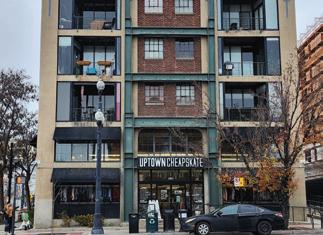






In the 1850s and 1860s, homesteaders settled in and around Park City at Snyderville Basin, Parleys Park and Kimball Junction. They harvested timber from the mountainsides, worked in the silver mines and grew food to feed their families. William Kimball built a stage coach station at the head of Parleys Canyon in 1862. He built a bridge there across the creek and a hotel that was noted for its great food. People like Walt Whitman and Mark Twain stayed there while travelers and business folk came and went on the Holladay Stage line and the Wells Fargo Express. While the original structures are gone, the pristine meadows remain.
Kimball Junction serves as a gateway to Park City and Deer Valley and locals have fought hard to preserve the vistas and plant and animal life in the vast green spaces there. It would be easy to bulldoze the valley and build expensive homes, but then that gasp of seeing the beauty of the area when we exit Interstate 80 toward Park City would be forever gone.
The Swaner Preserve is a 1,200-acre wildlife refuge near the properties of the Redstone and Newpark districts at Kimball Junction. It was gifted to Utah State University in 2010 for oversight. It’s not in danger of going away, but as land is precious, the privately held land around it is incredibly valuable to developer potential.
Dakota Pacific (DP) purchased the land near the preserve in 2018 and was approved to build a commercial tech center. Last year, the Utah Legislature passed—and Gov. Cox signed—SB 84, circumventing local land use authorities. Summit County then sued DP in 2023 and won an injunction to stop such a huge development, but DP appealed.
If the project goes forward, one of the biggest issues is traffic. Locals feel the developer needs to pay attention to the community as the current plan calls for overdeveloping the area and possibly increasing traffic at Kimball Junction by more than 3,700 cars a day.
Planners argue that combining housing and commercial spaces can reduce the demand for driving, and UDOT is exploring a new bus rapid transit line between Kimball Junction and Park City to help locals bypass traffic congestion.
The Summit County Council has met with DP, and the developer is going to bring more ideas to the table, especially regarding affordable housing and lower density. Stay tuned as growth vs. housing, density and transportation issues will continue to be hot topics around the state for years to come as we just keep growing and growing. n
26. Alcohol type used as biofuel
29. “Cats” poet’s monogram
31. Backward-looking
34. Night sky feline
35. Urban growth
38. What lumberjacks do
39. They’re on the books
41. Video game protagonist with a 2023 movie
42. Aucklander, casually
43. “Nah, it’s all good ...”
44. Use your blinker
46. Former All-Star closer Robb
47. Video game character on a roll?
49. Poe’s “Annabel ___”
50. Postal Service symbol
52. Piano practice piece
54. Bob ___ apples
55. “A Wrinkle in Time” director DuVernay
57. Tops that don’t require a bottle opener
63. Download the wrong way, maybe
65. Closet-organizing device
66. “Stormy” seabird
67. Winner’s take
68. Volunteer’s statement
69. Go for a spin?
70. “All opposed” reply
71. Heartless
1. Word before Ruth or Bjorn
2. Fiona, eventually
3. First name among astronauts
4. Rick often behind a slick click
5. Like some fuses or glass
6. Acronymic anxiety about exclusion
7. Part of WNBA
8. Take time to enjoy

9. Type of “mobile” for Oscar Mayer
10. Musical adaptation abbr.
11. Early score in a baseball or basketball game
12. 1980s tennis star Mandlikova
16. Talk excessively
18. Becomes less hot
21. Drink made from frozen grapes
25. Card pack
26. Author Bret Easton ___
27. “I love you,” in Spanish
28. Words of astonishment
29. Promo of sorts
30. “Beetle Bailey” character
32. Spiked wheel on a boot spur
33. State one’s views
36. Some U.K. statespeople
37. Mauna ___ (Hawaiian peak)
40. Comedy scene
45. Sierra ___ (Liberia neighbor)
48. General killed at Little Bighorn
51. Northern region
53. Flashlight battery size
54. Australian Rules, informally
55. Smartphone download
56. Vantage point
58. “SportsCenter” network
59. “Hold on there!”
60. West Coast gas brand
61. Bell ringing
62. Outlook action
64. Actress Graynor
Last week’s answers
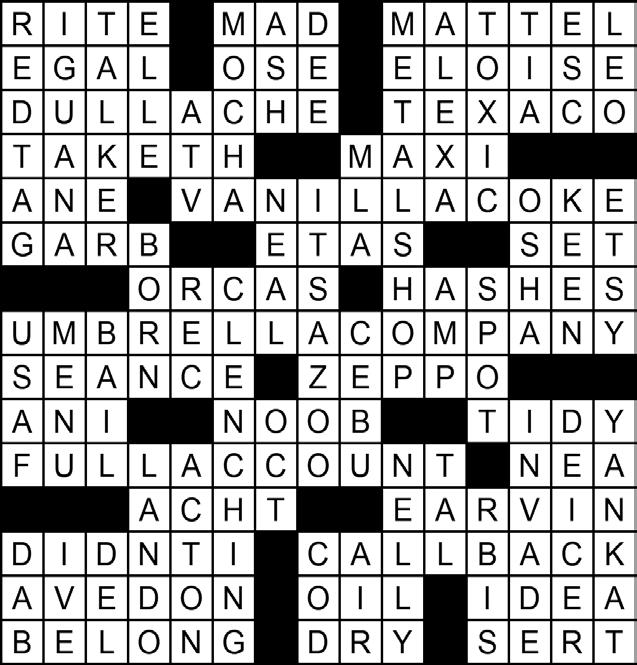

Wait, What?
In Atkinson, New Hampshire, a new business is stirring up controversy: The Diaper Spa is a haven for adults who role-play as children. Boston.com reported that the spa is open to “all diaper-wearing individuals who seek acceptance, respite and care.” The facility is decorated like a nursery, with toys and adult-size cribs. Services range from $200 an hour for virtual playdates to a $1,500-a-day experience that pampers “the little one inside of you.” The owner, Dr. Colleen Ann Murphy, said the community of ABDL (adult/baby diaper lovers) is vast. “Being a part of this community brings comfort and solace,” she said, and added that her services do not have a sexual component. Some Atkinson residents are concerned, though. “That is something that I will never be willing to expose my kids to,” said Kayla Gallagher. “People tend to fear anything that they fail to comprehend,” Murphy countered.
It’s a Mystery
n Brett Elmore, the general manager of WJLX-AM radio in Jasper, Alabama, thought he had misheard when he got a call on Feb. 2, The Washington Post reported. “The tower is gone,” his landscaper said. The 200-foottall steel structure that had broadcast the station for decades was gone, with cut wires and an empty concrete slab left behind. Elmore said police were “as bumfuzzled as I was.” Upon further investigation, he realized the padlock was missing from the small building adjacent to the tower, and the transmitter was also gone. “I have heard of thieves in this area taking anything,” Elmore said. “But this one takes the cake. If the tower is found, it’s probably in a million pieces.”
n The Lima family in Philadelphia are investigating an unidentified object that appeared on their roof on Feb. 7, NBC10-TV reported. Fabian Lima said he thought the 8-foot-tall flat piece of rusty metal with a large hole in it might have fallen from a plane, but “I would have thought it would have gone right through,” he said. The Limas called the Federal Aviation Administration, who told them to hold on to the item until given the “all-clear.” Later, the FAA said it had investigated and the object did not come from an aircraft.
Ewwwww
U.S. Customs and Border Protection reported on Feb. 11 that the agency had confiscated the dead and dehydrated bodies of four monkeys from the luggage of a traveler returning to Boston Logan International Airport from the Democratic Republic of Congo. The Associated Press reported that the traveler claimed he had dried fish, but a dog sniffed out something different. “Bushmeat” is banned in the U.S. because of the threat of disease, and the flyer said he had the monkeys for his own consumption. No charges were filed, but the luggage was seized and about 9 pounds of bushmeat were destroyed by the CDC.
When Bedford firefighters were called out to a horse farm in Westchester County, New York, on Feb. 5, they feared the worst, NBC4-TV reported. Fortunately, it was a false alarm—probably activated by Jax the horse, who refused to answer any questions about his shenanigans, the department said in a Facebook post. “Evidently, he was able to reach out from his stall and bite down on the alarm to set it off.”
The Chinese take their pandas very seriously, as one Mr. Gao found out on Feb. 12 at the Chengdu Research Base of Giant Panda Breeding in Sichuan province. The Associated Press reported that Gao, 53, threw unspecified “objects” into the panda enclosure, which is strictly prohibited. “In view of Gao’s uncivilized visit and his behavior that may cause harm to giant pandas, he is prohibited from entering the panda base ... for life,” the base announced. “The national treasure has strict dietary standards.”
Poor Joey. The donkey, 15, who lives in Sidmouth, England, lost his mom, Josie, in November, and he hasn’t been himself since, Metro News reported. In his grief, Joey stopped eating properly and developed a gastric impaction that threatened his life. Luckily, vets devised a sweet solution: “As well as pain relief, we flushed Joey’s stomach with cola several times a day to dissolve the solid,” veterinarian Jamie Forrest said. “We used 6 liters of full-sugar cola a day ... In essence the cola acted like a drain cleaner.” Folks at Slade House Farm also hooked Joey up with Ben, another donkey who lost his best friend, Bob, late last year. “We hoped their shared experience of loss would allow them to comfort each other,” said groom Kayleigh Yelland. “Their friendship is still flourishing. It’s early days.”
Charlotte, a stingray who lives at the Aquarium & Shark Lab in Hendersonville, North Carolina, is pregnant, but scientists are stumped because there are no male stingrays in her tank. WBTV reported on Feb. 12 that Brenda Ramer, the founder of the aquarium, said she noticed bite marks on Charlotte’s body and suspects that they were made by either Moe or Larry, the young male sharks that live with her in the tank. Since it’s impossible for those two species to interbreed, the only other explanation could be parthenogenesis, where eggs develop without fertilization and create a clone of the mother. Ramer doubts that’s the case, because it’s rare in rays in captivity: “It’s a ‘once in the bluest of blue moons’ experience.”
Anthony Lewis, 33, of Winter Haven, Florida, wanted to surprise his ex-girlfriend, and maybe lure her back, with a unique Valentine’s Day gift. So he picked up a couple of crane statues—out of someone else’s front yard. Fox13TV reported that Lewis was on his motorcycle when he snatched the cranes, which were “very special” to the owner because her deceased husband had given them to her. Polk County Sheriff Grady Judd said the girlfriend was “mortified” and cooperated with law enforcement. Lewis, who has 39 priors, was arrested. “If this guy’s in the area, he’ll steal it,” Judd said.
In Washington, D.C., a Walgreens store has been robbed at least once a month since July 2023, WUSA-TV reported. On Feb. 13, Metropolitan Police Chief Pamela A. Smith announced that three men had been arrested in connection with the robberies—including the store’s manager. In every robbery, she said, 24-year-old Kamanye Williams allegedly entered the storeroom and waited for an employee to open a secure door. Then he demanded money and fled. Michael Robinson, 33, the manager, and his nephew, 26-year-old Gianni Robinson, were also arrested and charged with conspiracy to interfere with interstate commerce by robbery. Smith said Williams was in touch with both men before and after each robbery.
Three Chesterfield County (South Carolina) sheriff’s deputies were charged on Feb. 12 with misconduct in office, criminal conspiracy and breach of peace, Queen City News reported. Justin Reichard, Darien Roseau and Killian Loflin are accused of making prank phone calls to other law enforcement agencies, reporting hoax emergencies—including the discovery of a dead body. “The hoax calls caused emergency responses from law enforcement and/or other emergency responders,” the South Carolina Law Enforcement Division reported. Officers tracked the phone number where the calls came from to one of the former deputies. All three are free, awaiting trial.
Send your weird news items to WeirdNewsTips@amuniversal.com


























